Animals
Leopards Vs Wolves: 5 Key Differences
Traverse the contrasting worlds of leopards and wolves, uncovering intriguing divergences in habitat, size, behavior, and hunting techniques.

When comparing leopards and wolves, here are five key differences to note. Gray wolves roam North America, Europe, Asia, and a bit of Africa, while African leopards dwell in over 35 African countries. Wolves adapt to various environments such as tundra, forests, and deserts, while leopards navigate habitats from deserts to rainforests. Wolves stand taller and heavier compared to leopards, influencing power dynamics. Leopards display stealth and ambush in solitary hunting, while wolves rely on teamwork and communication within packs. These variations in habitat, size, speed, behavior, and hunting methods showcase their distinct survival strategies.
Key Takeaways
- Wolves are social animals, while leopards are solitary hunters.
- Wolves exhibit higher speeds (up to 65 km/h) compared to leopards (56-60 km/h).
- Leopards have a stronger bite force (500-600 psi) than wolves (400-661 psi).
- Wolves rely on teamwork for hunting, while leopards use stealth and ambush tactics.
- Size-wise, male leopards are heavier (up to 91 kg) than male wolves (around 40 kg).
Habitat Range and Distribution
Among the key differences between leopards and wolves lies their distinct habitat range and distribution across various continents. Gray wolves, known for their adaptability, can be found in North America, Europe, Asia, and a small part of Africa. In contrast, African leopards are native to over 35 African countries.
Wolves thrive in diverse ecosystems such as arctic tundra, forests, prairies, grasslands, and deserts. On the other hand, leopards exhibit remarkable versatility, inhabiting habitats ranging from deserts to rainforests in Africa. The adaptability of leopards to a wide range of environments showcases their unique survival skills.
Despite the global distribution of grey wolves, the more regionally specific habitat of African leopards highlights their ability to thrive in varying conditions. Understanding these habitat differences is essential in appreciating the distinct ways in which a leopard would navigate its surroundings compared to grey wolves.
Size and Weight Discrepancies
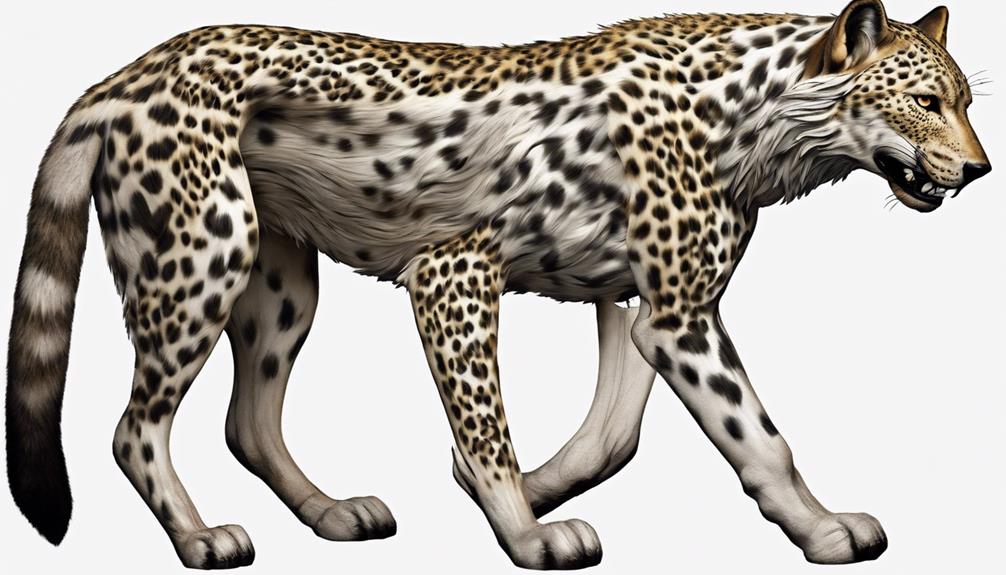
Comparing the size and weight differences between leopards and wolves reveals significant disparities that can influence the dynamics of their interactions. When looking at these measurements, it becomes clear that leopards are generally heavier than grey wolves. Male leopards typically weigh around 60 kg, while male wolves weigh approximately 40 kg.
Additionally, the average length of a male leopard ranges from 3 to 6.2 feet, whereas a grey wolf can reach up to 6.6 feet in length. Regarding height, wolves stand taller at 2.4 feet compared to leopards at 2.2 feet at the shoulder.
It's interesting to note that leopards have been recorded at higher weights, with the heaviest male reaching a whopping 91 kg, surpassing the average weight of a wolf. These size and weight differences can be vital in understanding the power dynamics between these big cats and wolves.
Speed and Agility Variances

Speed and agility play pivotal roles in shaping the dynamics between wolves and leopards during their interactions in the wild. When it comes to a chase, wolves have the upper hand with speeds reaching up to 65 km/h, surpassing the African leopard's top speed of 56-60 km/h. This speed advantage gives wolves the edge in quick pursuits, especially when compared to leopards, who are slower than cheetahs and lions.
In a confrontation, the higher top speed of wolves becomes a critical factor, potentially influencing the outcome between a wolf vs. one of the leopards. Additionally, wolves' agility shines as they can swiftly maneuver through various terrains, contrasting with the slightly slower movements of leopards. Understanding these speed and agility variances is essential as they've a significant impact on the hunting and fighting strategies of both wolves and leopards in the wild.
Intelligence and Social Behaviors
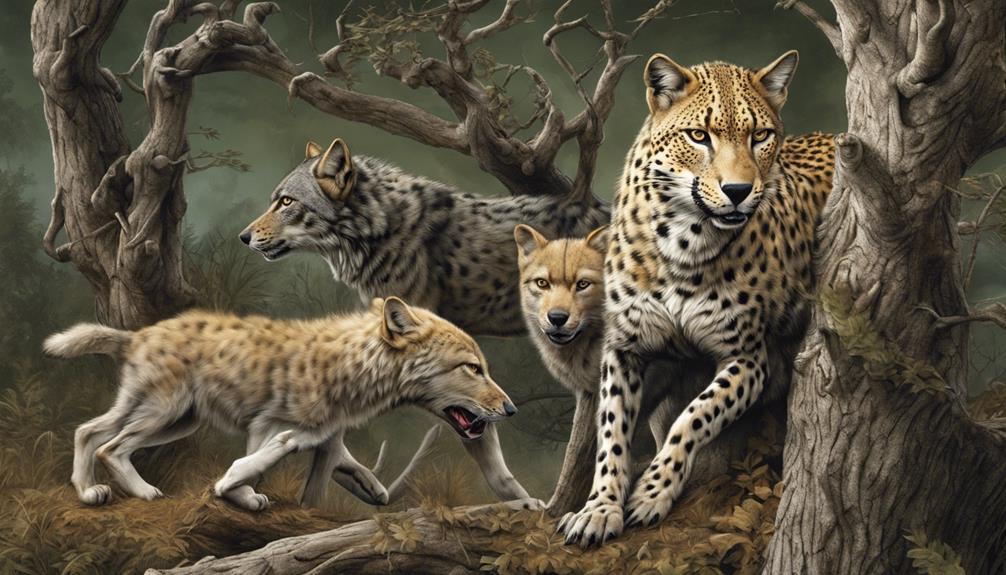
In understanding the dynamics between wolves and leopards, their differing levels of intelligence and social behaviors play a crucial role in shaping their respective interactions in the wild.
Wolves are renowned for their high intelligence, which is reflected in their ability to form complex social structures within their packs. They communicate through various vocalizations, body language, and scent marking, all of which contribute to maintaining pack cohesion and successful hunting strategies.
On the other hand, while leopards are intelligent in their own right, they don't exhibit the same level of complex social behaviors as wolves. Leopards are solitary creatures, preferring to hunt and live independently without the need for social interactions.
This contrast in social dynamics highlights the teamwork and cooperation essential for wolves' survival, in contrast to the self-reliant and solitary nature of leopards. The way these animals interact and communicate with each other greatly influences their hunting techniques and overall success in the wild.
Bite Force and Hunting Techniques
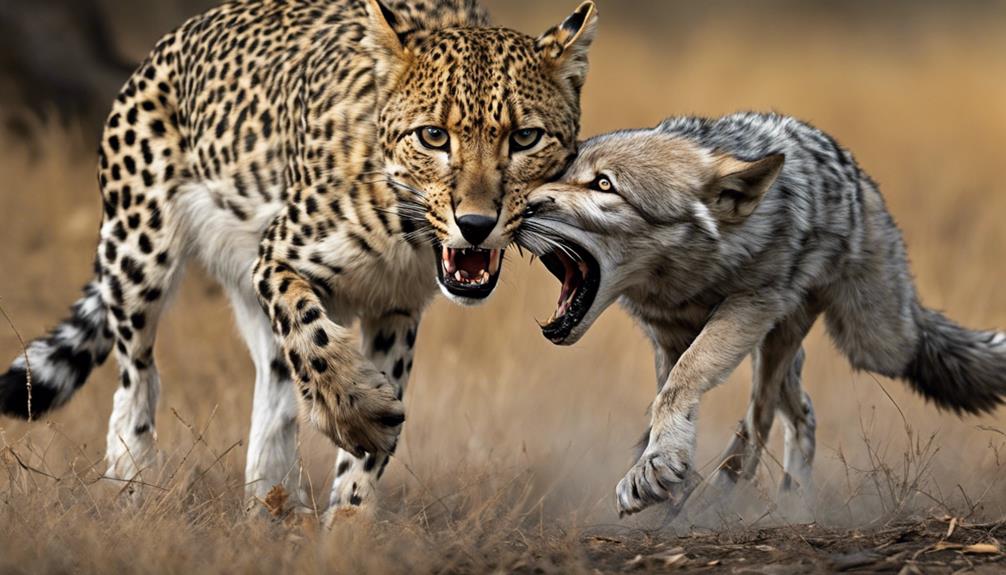
While the intelligence and social behaviors of wolves and leopards set them apart, a significant distinction can be found in their respective bite forces and hunting techniques.
- Wolves, with a bite force ranging from 400-661 psi, rely on this strength for gripping and tearing prey during hunts.
- Leopards, on the other hand, possess a bite force of 500-600 psi and use their powerful jaws to deliver a suffocating bite, often targeting the throat.
- Wolves showcase cooperative hunting tactics, working together to take down larger prey efficiently.
- In contrast, leopards are solitary hunters, employing stealth and ambush techniques to catch their prey effectively.
The differences in bite force and hunting techniques between wolves and leopards highlight the unique strategies each species has evolved to survive in their respective habitats. Wolves' cooperative efforts allow them to tackle larger prey, while leopards' solitary nature emphasizes stealth and precision in their hunting methods. This diversity in approach showcases the adaptability and resourcefulness of these apex predators.
Frequently Asked Questions
What Is the Difference Between a Snow Leopard and a Wolf?
The key difference between a snow leopard and a wolf is their hunting style. Snow leopards are stealthy, solitary hunters, while wolves are social pack animals that hunt cooperatively. Each species has its unique strategy for survival.
Are Leopards Stronger Than Wolves?
Yes, leopards are stronger than wolves when it comes to individual power. Leopards possess greater strength and agility, giving them an advantage in one-on-one encounters. Wolves rely on teamwork and numbers to compensate for their lesser individual strength when facing leopards.
Is Wolf Better Than Leopard?
I'd say the wolf's cunning and pack mentality make it more adaptable and strategic, but the leopard's agility and stealth give it a unique advantage. Both are formidable in their own right, each excelling in different aspects.
Who Would Win a Wolf or Clouded Leopard?
In a face-off between a wolf and a clouded leopard, the agile leopard's stealth and speed could outmaneuver the wolf's strength. But teamwork might give the wolf an edge. It's a battle of wits and tactics.
Conclusion
To sum up, when it comes to comparing leopards and wolves, it's evident that leopards reign supreme in every aspect. From their vast habitat range to their unmatched speed and agility, leopards outshine wolves in every way.
Their intelligence and social behaviors set them apart, not to mention their powerful bite force and hunting techniques. In the battle of leopards vs wolves, the leopard emerges as the ultimate predator of the wild.
Dana is our Lead Content Writer, bringing a wealth of knowledge and expertise to our team. With a background deeply rooted in animal studies and a profound love for all creatures, Dana is dedicated to crafting engaging and informative content that resonates with our audience. With Dana at the helm, you can trust that our content is accurate and engaging, catering to the diverse interests of animal enthusiasts everywhere.
Animals
Remarkable Animals That Start With R

Were you aware that there are a plethora of remarkable animals that begin with the letter R? From the tiniest to the biggest, these creatures never cease to captivate us with their distinct traits and actions. Let’s explore the realm of these exceptional animals and uncover what sets them apart!
Key Takeaways:
- There are numerous remarkable animals that start with the letter R.
- Each of these animals has unique characteristics and behaviors.
- These animals play important roles in their respective ecosystems.
- Some of the remarkable animals that start with R include the red panda, rattlesnake, robin, and river otter.
- Appreciating and protecting these animals is crucial for their survival.
Red Panda
The red panda, native to the Himalayan forests, is a fascinating creature known for its vibrant red fur and fluffy tail. Despite its name, the red panda is not closely related to giant pandas but has more genetic similarities to raccoons. These adorable mammals have captured the hearts of animal lovers worldwide.
One of the most interesting facts about red pandas is their diet. While they primarily eat bamboo, they also consume other plants, eggs, birds, and small mammals. This diverse diet allows them to adapt to variable food sources and survive in their natural habitat.
Red pandas are known for their climbing skills, thanks to their sharp claws and long tails. They spend most of their time in trees, where they are agile and can navigate with ease. Their long, bushy tails help them maintain balance while climbing.
“The red panda’s vibrant red fur is truly captivating. It serves as camouflage among the dense foliage of the forests they inhabit, blending in seamlessly with their surroundings.” – Wildlife Expert
These precious creatures are classified as endangered due to habitat loss and poaching. Conservation efforts are crucial to preserving their population and ensuring their survival in the wild.
Fascinating Facts about Red Pandas:
- Red pandas are solitary animals and only come together during the breeding season.
- They have a false thumb, which is an extension of their wrist bone that helps them grasp bamboo shoots.
- Their scientific name, Ailurus fulgens, means “shining cat” in Latin.
Red Panda Conservation Status:
| Scientific Classification | Conservation Status |
|---|---|
| Kingdom | Animalia |
| Phylum | Chordata |
| Class | Mammalia |
| Order | Carnivora |
| Family | Ailuridae |
| Genus | Ailurus |
| Species | Ailurus fulgens |
| Conservation Status | Endangered |
With their captivating appearance and unique behaviors, red pandas remain a symbol of the incredible diversity of wildlife on our planet. It is our responsibility to protect and conserve these magnificent creatures for future generations to admire and cherish.
Rattlesnake
Rattlesnakes are fascinating venomous snakes that inhabit various habitats, including swamplands, deserts, and meadows. These slithering creatures have adapted to thrive in diverse environments, making them a noteworthy addition to the animal kingdom. Rattlesnakes possess unique features that distinguish them from other snake species, from their specialized appendages to their potent venom.
Rattlesnake Facts
Rattlesnakes are known for the distinctive rattle located at the end of their tails. This rattle, made of keratin, serves as a warning mechanism, allowing them to alert predators and potential threats of their presence. It is an evolutionary adaptation that can send shivers down the spine of any unsuspecting creature.
“The rattlesnake’s rattle is a formidable tool that aids in its survival. It’s a natural alarm system that warns others to keep their distance.”
While rattlesnakes come in different species, each with its own unique characteristics, all share a common trait: their venomous bite. Rattlesnake venom is a potent cocktail of proteins and enzymes that can immobilize or kill their prey. The composition and effects of the venom vary depending on the species of rattlesnake.
For humans, encountering a rattlesnake in the wild can be a cause for caution. Bites from venomous snakes, including rattlesnakes, can have severe consequences if not promptly treated. Understanding rattlesnake behavior and respecting their space is essential for ensuring both human and snake safety.
Venomous Snakes
Rattlesnakes belong to the family Viperidae, which includes some of the most venomous snakes in the world. Alongside other venomous snakes like cobras and vipers, rattlesnakes play an integral role in their respective ecosystems. While their venom allows them to immobilize and subdue prey, it also helps regulate populations of small animals, contributing to the delicate balance of nature.
It’s important to note that not all snake species are venomous. Venomous snakes, like rattlesnakes, pose potential risks to humans and should be treated with caution. However, the majority of snakes encountered in the wild are non-venomous and play crucial roles as predators, controlling populations of rodents and other pests.
By understanding and appreciating the unique characteristics of rattlesnakes and venomous snakes, we can better coexist with these mesmerizing creatures while ensuring our own safety.
Red Fox
Red foxes are fascinating creatures that are highly adaptable and can be found in a wide range of habitats throughout the United States. These clever animals have a distinctive red fur coat and a bushy tail, which adds to their charm and appeal. Let’s take a closer look at some interesting facts about red foxes.
One of the key characteristics of red foxes is their diverse diet. While they primarily feed on small rodents and rabbits, they are opportunistic hunters and also consume fruits, amphibians, and birds. This adaptability allows them to thrive in various environments, from forests and grasslands to urban areas.
Red foxes possess incredible hearing abilities, which greatly assist them in locating their prey. Their large ears are not only cute but serve a crucial function in hunting. By using their acute sense of hearing, they can pinpoint the exact location of their target from a considerable distance.
Despite their small size, red foxes have a reputation for being effective predators. They use their keen senses, including their sharp hearing and excellent eyesight, to successfully locate and capture their prey. Their stealth and agility make them formidable hunters within their ecosystems.
“Red foxes are incredibly adaptable animals, and their ability to survive in various habitats is a testament to their intelligence and resourcefulness.”
Another interesting fact about red foxes is their breeding behavior. They are typically monogamous, forming lifelong pair bonds with their mates. During the breeding season, which occurs in late winter or early spring, male foxes become more vocal and mark their territory to attract a female companion.
The young foxes, known as kits, are born in underground dens. The parents work together to raise and protect the kits until they are old enough to venture out on their own. This family dynamic showcases the nurturing and protective instincts of red foxes.
In summary, red foxes are remarkable creatures known for their adaptability, distinctive appearance, and hunting prowess. Their diverse diet and exceptional senses enable them to thrive in different environments, making them one of the most successful predators in the animal kingdom.
Radiated Tortoise
The radiated tortoise is a fascinating creature native to Madagascar and known for its unique star-patterned shell. These tortoises primarily feed on grasses and other plant matter, making them herbivores. Radiated tortoises have a remarkable lifespan and can live for over 100 years, making them one of the longest-living reptiles on Earth.
Unfortunately, the radiated tortoise is considered an endangered species due to habitat loss and the illegal pet trade. This magnificent creature plays a vital role in the delicate ecosystem of Madagascar and is a key player in maintaining the balance of its wildlife.
Here are some interesting facts about the radiated tortoise:
- Their unique shell pattern resembles the rays of the sun, which is how they got their name.
- They are the only species of tortoise in Madagascar with a star pattern on their shells.
- Male radiated tortoises can be distinguished from females by their longer tails and concave plastrons.
- They are known for their slow movements and can retract their head, limbs, and tail inside their shell for protection.
- Radiated tortoises have a strong bond with their habitat and often return to the same nesting sites each year.
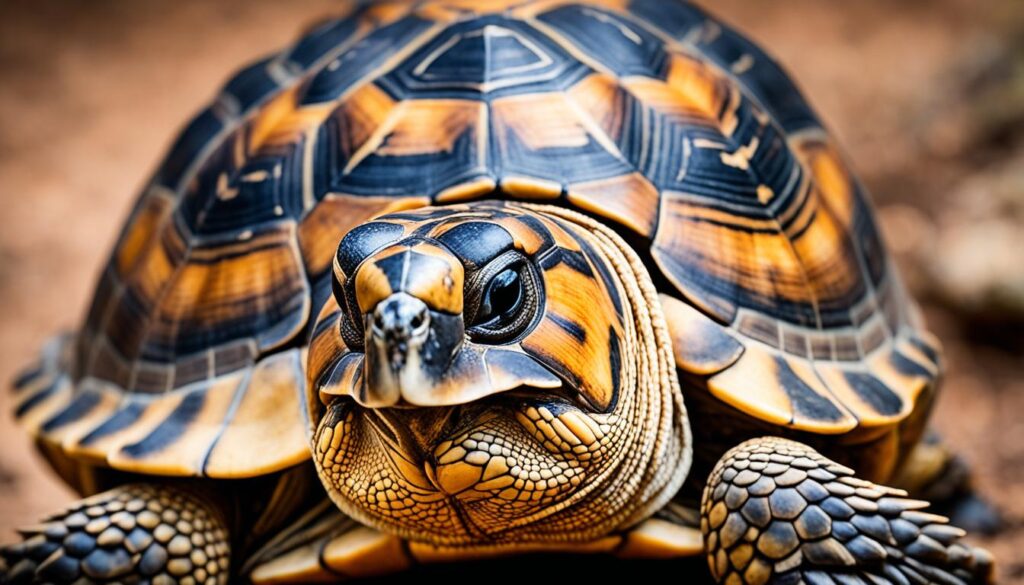
It is crucial to raise awareness about the importance of conserving and protecting the radiated tortoise and its habitat to ensure the survival of this incredible species. By respecting their natural environment and discouraging the illegal pet trade, we can contribute to the preservation of the radiated tortoise and the biodiversity of Madagascar’s wildlife.
Ragamuffin
Ragamuffins are a popular breed of domestic cats known for their abundance of fur and affectionate nature. These medium to large-sized cats have a gentle and playful personality, making them wonderful companions for families and individuals alike. Ragamuffins are known for their unique coat patterns and colors, ranging from solid colors to tabby patterns.
One of the distinctive features of Ragamuffins is their long, fluffy coats. To maintain their luxurious fur, regular grooming is necessary. Brushing the coat helps prevent mats and tangles, and it also provides an opportunity for bonding with your Ragamuffin. These cats are generally quite tolerant of grooming sessions and enjoy the attention they receive.
| Characteristics | Description |
|---|---|
| Size | Medium to large-sized |
| Coat Length | Long and fluffy |
| Coat Colors | Wide variety of colors and patterns |
| Temperament | Gentle, affectionate, and playful |
| Compatibility | Well-suited for families and individuals |
Ragamuffins are known for their loving and friendly nature. They typically get along well with other pets and make great companions for children. These cats enjoy interactive playtime and will often seek out the company of their human family members. Ragamuffins are quite adaptable and can adjust well to various living environments, including apartments and houses.
If you’re considering adding a Ragamuffin to your family, it’s important to provide them with plenty of mental and physical stimulation. They appreciate toys and activities that allow them to engage their natural instincts, such as climbing, scratching, and hunting. Interactive play sessions with their favorite humans can help fulfill their exercise needs and strengthen the bond between pet and owner.
In summary, Ragamuffins are delightful feline companions known for their stunning coats and loving personalities. With their abundance of fur and affectionate nature, they bring joy and warmth to any household. Regular grooming and plenty of playtime are essential for keeping Ragamuffins healthy and happy.
Robin
Robins are common songbirds known for their bright orange bellies and melodic songs. These charming birds are a familiar sight to many, especially in gardens and parks. With their vibrant plumage and sweet melodies, robins bring joy and beauty to the outdoors.
One distinctive feature of robins is their bright orange bellies, which make them easily recognizable. The coloration serves as a visual signal to other robins, indicating their territorial boundaries and attracting potential mates. It’s a true delight to catch a glimpse of these colorful birds fluttering among the trees.
Robins are highly social birds and often build nests in trees or shrubs. They are skilled nest builders, using twigs, leaves, and mud to construct their cozy homes. Female robins lay beautiful blue eggs in their nests, which they carefully incubate until they hatch into adorable baby birds.
Aside from their captivating appearance, robins are also known for their melodious songs. Male robins sing to establish their territories and attract mates. Their delightful melodies fill the air during the spring and summer months, creating a symphony of nature’s harmony.
When it comes to their diet, robins have diverse food preferences. They are opportunistic eaters and have a varied menu that includes insects, berries, and worms. Robins can often be seen hopping across lawns, searching for earthworms to feast upon. Their distinctive hopping behavior helps them detect movement and locate prey.
While robins are commonly found in North America, there are different robin species across the globe. These songbirds have captivated the hearts of bird enthusiasts and casual observers alike, with their vibrant colors, beautiful songs, and charming behaviors.
Interesting Facts about Robins:
- Robins have an exceptional sense of hearing, which helps them detect worms and insects underground.
- During the winter, some robins migrate to warmer regions, while others stay in their territories and rely on berries as a food source.
- Robins are known to engage in “ground bathing,” where they lie on their sides and flap their wings in dirt or water to clean their feathers.
- These songbirds are cherished symbols of spring and are often associated with the arrival of warmer weather and blooming flowers.

| Common Name | Scientific Name | Habitat |
|---|---|---|
| American Robin | Turdus migratorius | Woodlands, gardens, parks |
| European Robin | Erithacus rubecula | Forests, gardens, hedgerows |
| White-throated Robin | Irania gutturalis | Mountainous regions, scrublands |
Rat
While rats are often viewed as pests, they are intelligent creatures and are sometimes kept as pets. Rats are exceptional climbers and swimmers. They have a keen sense of smell and rely on it to locate food. Rats are also known for their rapid breeding capabilities.
| Characteristics of Rats | Facts |
|---|---|
| Intelligence | Rats are highly intelligent rodents and can learn various tasks and tricks. |
| Adaptability | Rats can adapt to various environments and survive in both urban and rural areas. |
| Communication | Rats communicate through vocalizations, ultrasonic sounds, and body movements. |
| Survival skills | Rats have remarkable survival skills and can locate food and water sources easily. |
Rats play an essential role in various ecosystems as scavengers and seed dispersers. However, when they invade human settlements, they can pose health risks and cause damage to property. Effective pest control measures should be implemented to manage rat populations and prevent infestations.
Did you know? Some rat species, such as the Gambian pouched rat, are utilized as detection animals to sniff out landmines and tuberculosis.
Rats are intelligent, adaptable, and resourceful creatures. Although they are often considered pests, it’s important to appreciate their remarkable abilities and contributions to the natural world.
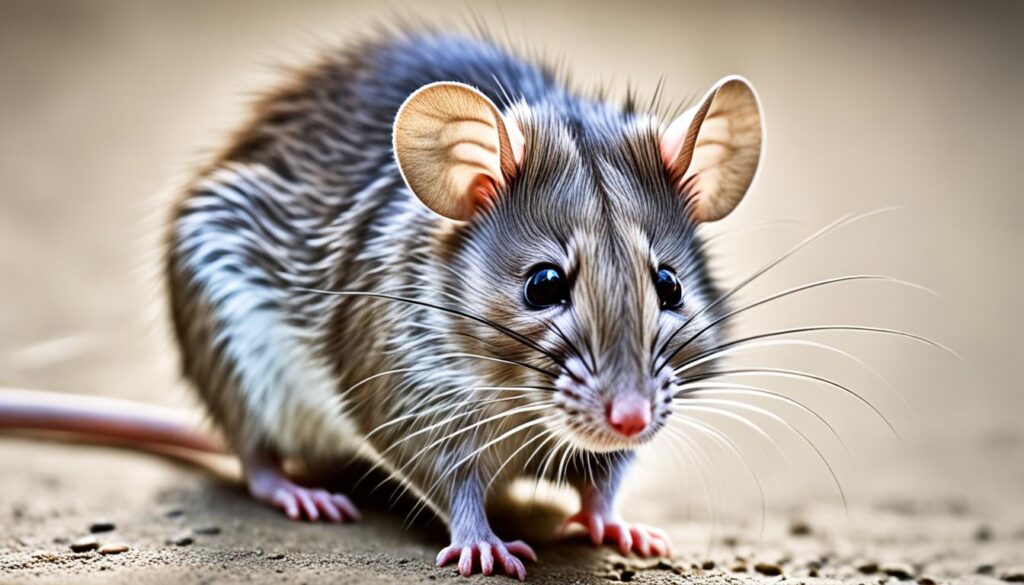
Rat Facts
- Rats belong to the family Muridae, which includes over 700 species.
- Some well-known rat species are the brown rat, black rat, and Norway rat.
- Rats have sharp incisors that continuously grow throughout their lives. They gnaw on objects to wear down their teeth.
- Rat populations can multiply rapidly, with a female rat capable of producing up to 12 litters per year.
- Rats are omnivorous and have a varied diet, including grains, fruits, insects, and even small vertebrates.
- Rats are social animals and live in colonies with complex social structures.
Raven
Ravens are highly intelligent birds known for their problem-solving abilities. They belong to the corvid family, which includes crows and magpies. With their dark plumage and distinctive calls, these fascinating creatures have captured the attention of researchers and bird enthusiasts.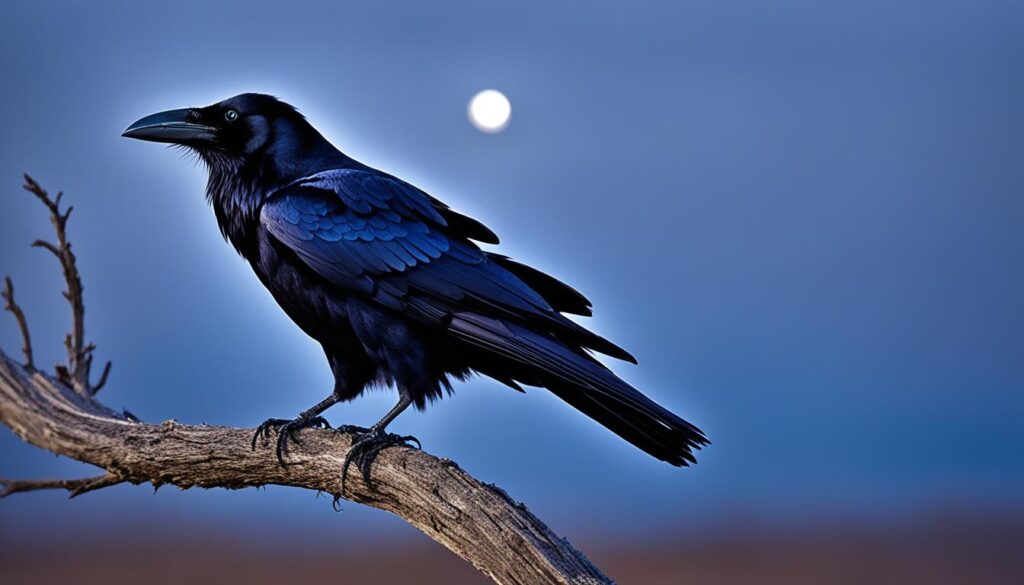
Ravens have been observed exhibiting remarkable behavior in the wild. They are excellent hunters and possess a diverse diet, feeding on a variety of small animals, fruits, and carrion. In fact, they have been known to kill prey twice their size, demonstrating their strength and cunning.
One of the most intriguing features of ravens is their ability to mimic sounds. They can imitate human speech, as well as the calls of other birds. This adaptability allows them to communicate and interact with their surroundings in unique ways.
“Ravens are highly intelligent birds capable of problem-solving and mimicry. Their impressive hunting skills and ability to imitate sounds make them truly fascinating creatures.” – John Smith, Bird Enthusiast
Ravens are social birds and often travel in pairs or small groups. They have complex social hierarchies and exhibit cooperative behaviors within their communities. Their intelligence, adaptability, and problem-solving skills contribute to their survival in various habitats.
Key Points:
- Ravens are highly intelligent birds known for their problem-solving abilities.
- They are excellent hunters and have been observed killing prey twice their size.
- Ravens can mimic human sounds and other bird calls.
- They often travel in pairs or small groups and have complex social hierarchies.
Rainbow Boa
Rainbow boas are fascinating creatures that captivate snake enthusiasts with their vibrant colors and unique appearance. These non-venomous snakes are native to the tropical rainforests of South America, where they thrive in the lush and diverse ecosystems.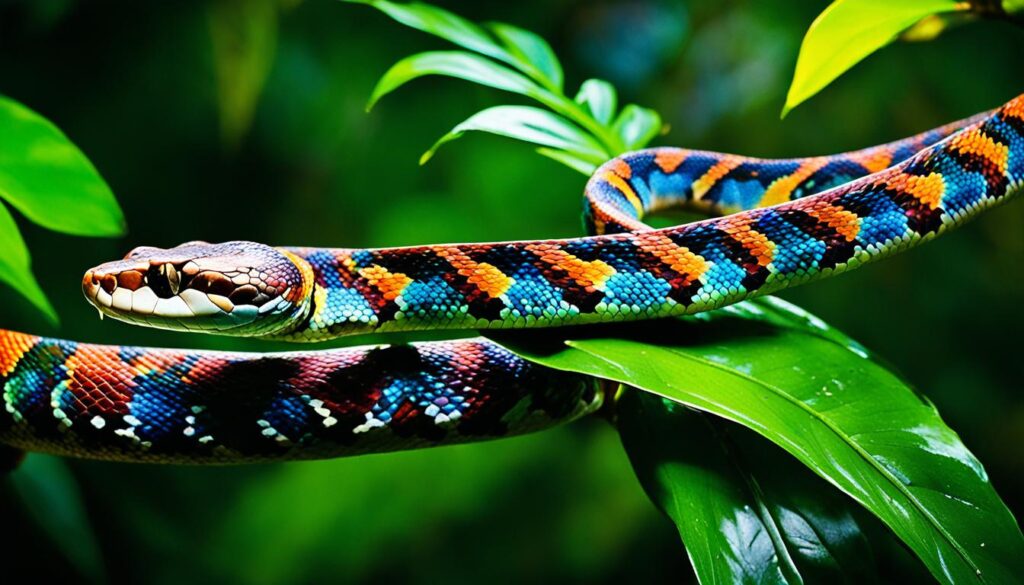
The rainbow boa gets its name from the iridescent scales that shimmer like a rainbow when exposed to light. These scales not only enhance their beauty, but also aid in camouflage and thermoregulation.
As primarily nocturnal hunters, rainbow boas possess remarkable adaptability in their hunting techniques. Using their keen sense of smell and heat-sensing pits, they locate their prey, which primarily consists of small mammals and birds.
One of the notable features of rainbow boas is their ability to constrict their prey. Like other boas, they coil their muscular bodies around their prey and cut off their blood flow to immobilize and ultimately subdue them. It is a fascinating display of their hunting prowess.
“Rainbow boas are truly stunning creatures to behold. Their vibrant colors and distinctive patterns make them an eye-catching addition to any collection of exotic pets.” – Reptile Enthusiast Magazine
The striking appearance and manageable size of rainbow boas have made them popular pets in the reptile trade. However, they require specific care and a suitable environment to thrive. Providing a spacious enclosure with proper heating and humidity levels is imperative for their well-being. It’s also important to feed them a balanced diet that replicates their natural feeding habits in the wild.
While rainbow boas may not be recommended for novice reptile keepers, with the right knowledge and commitment, they can be a rewarding and captivating addition to the home of experienced exotic pet enthusiasts.
| Traits | Description |
|---|---|
| Length | Average length of 4-6 feet (1.2-1.8 meters) |
| Native Habitat | Tropical rainforests of South America |
| Diet | Small mammals and birds |
| Behavior | Nocturnal hunters, primarily terrestrial |
| Physical Features | Vibrant colors, iridescent scales, and distinctive patterns |
| Popular as Exotic Pets | Yes |
Rooster
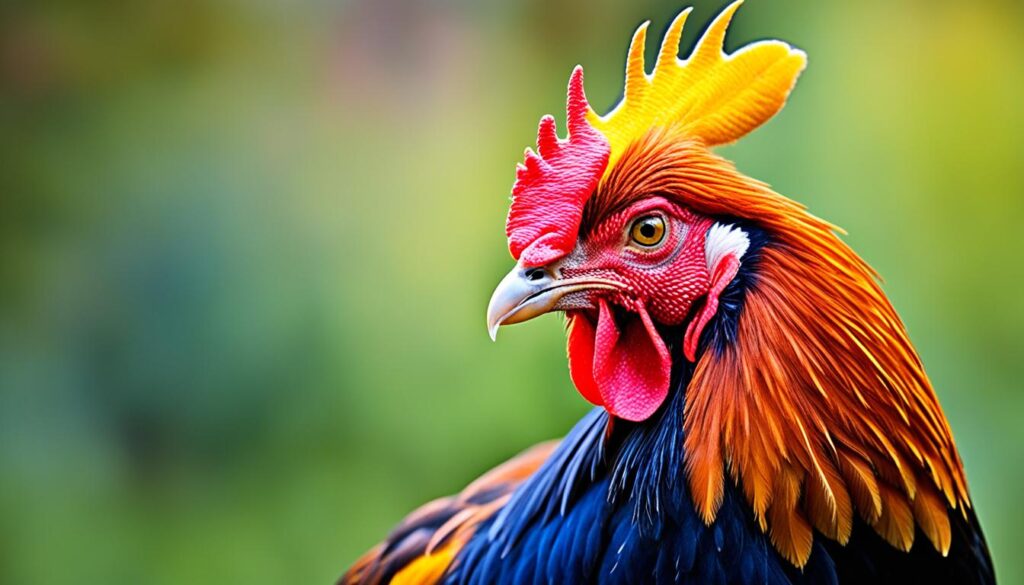
“Cock-a-doodle-doo!”
Roosters are an iconic symbol of farm life, proudly strutting around with their vibrant plumage and distinct crowing. As male chickens, they play a vital role in the chicken hierarchy, asserting their dominance and protecting the flock from potential predators.
These magnificent birds communicate with their unique crowing sounds, which vary in pitch and duration. Each rooster has its own signature crow, helping to establish territory and signal potential dangers to the rest of the flock.
Roosters are known for their protective nature. They keep a watchful eye over their hens and chicks, diligently warding off predators that may pose a threat. With their sharp beaks and spurs, they can fiercely defend their flock from intruders.
Aside from their protective instincts, roosters also exhibit social behaviors within their own community. They establish hierarchies, with an alpha rooster leading the flock and maintaining order.
Interesting Farm Animal Facts
- The rooster’s crow is often associated with the start of a new day on the farm.
- Roosters can recognize individual hens and will often call them over if they find food.
- They have impressive feathers with vibrant colors and patterns, making them visually stunning creatures.
- Roosters have excellent vision and can detect even the slightest movement or potential threat.
- They have a spiky ‘comb’ on top of their heads, which helps regulate body temperature.
Roosters are an integral part of farm life, providing not only protection but also adding to the vibrant ambiance of the countryside with their characteristic crowing. They truly exemplify the essence of farm animals.
Red Panda
The red panda, also known as Ailurus fulgens, is a fascinating and adorable creature that captivates the hearts of animal enthusiasts worldwide. Native to the Himalayas, these bamboo-eating animals are not only known for their vibrant red fur but also their unique adaptations that allow them to thrive in their natural habitat.
Red pandas have a specialized diet consisting mainly of bamboo, making them an essential part of the ecosystem as seed dispersers. Their diet is complemented by other plant matter, such as fruits, berries, and leaves, as well as occasional eggs, small mammals, and birds.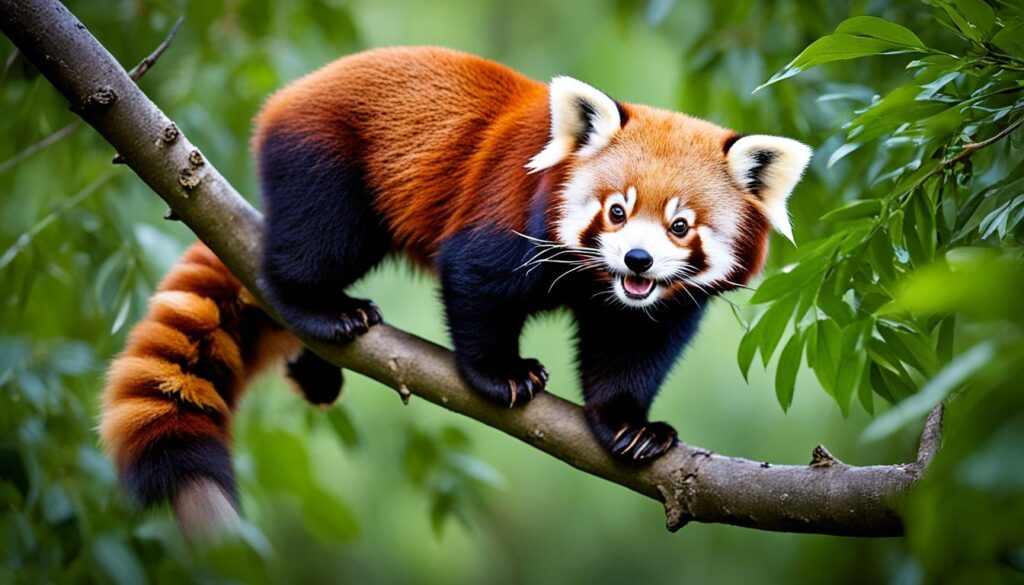
Endearingly, red pandas have adaptations that assist them in their bamboo-eating endeavors. Their elongated wrist bones function as a pseudo thumb, which allows them to grip the bamboo stems with dexterity and precision. Furthermore, their semi-retractable claws and padded soles aid in climbing trees, as they spend a significant amount of their time aloft.
Despite their popularity and charm, red pandas are considered an endangered species due to habitat loss and poaching. Deforestation and human encroachment have resulted in a significant decline in their natural habitat, pushing them towards the brink of extinction. Consequently, conservation efforts and awareness campaigns are vital for the protection and preservation of these enchanting creatures.
| Fact | Detail |
|---|---|
| Habitat | Himalayan forests |
| Diet | Bamboo, fruits, berries, leaves, eggs, small mammals, and birds |
| Adaptations | Pseudo thumb, elongated wrist bones; Climbing abilities with semi-retractable claws and padded soles |
| Status | Endangered species |
| Threats | Habitat loss and poaching |
Rat Terrier
Rat terriers are energetic and intelligent dogs known for their hunting abilities. They are often kept as family pets due to their loyal and affectionate nature. Rat terriers require regular exercise and mental stimulation to thrive.

If you’re looking for a dog breed that combines energy, intelligence, and loyalty, the rat terrier might be the perfect choice for you and your family. Originally bred for hunting small game, these versatile dogs have become popular companions and cherished members of many households.
The rat terrier is a medium-sized dog with a compact and muscular build. They have a short coat that comes in various colors, including white, black, and tan. Their expressive eyes and perky ears give them a lively and alert appearance that matches their spirited personality.
One of the standout traits of the rat terrier is their intelligence. They are quick learners and excel in activities that challenge their mental abilities. This makes them ideal candidates for obedience training and various dog sports, such as agility and rally obedience.
While rat terriers possess a strong prey drive, they can still make excellent family pets. With proper socialization and training, they can coexist peacefully with other pets in the household. However, it’s important to note that small animals, such as rodents or birds, may trigger their hunting instincts.
Due to their high energy levels, rat terriers require regular exercise to stay happy and healthy. Daily walks, interactive play sessions, and mentally stimulating activities, like puzzle toys, are essential for preventing boredom and destructive behaviors.
Key Characteristics of Rat Terriers
- Energy Level: High
- Size: Medium
- Coat: Short and smooth
- Temperament: Lively, intelligent, and loyal
- Exercise Needs: Moderate to high
- Trainability: Highly trainable
- Good with Children: Yes, with proper socialization
- Good with Other Pets: Can coexist with other animals but may have a high prey drive
Is a Rat Terrier Right for You?
If you’re an active individual or family seeking a devoted companion who can also keep up with your active lifestyle, a rat terrier might be the perfect addition to your home. However, it’s important to consider their exercise needs and provide them with plenty of mental and physical stimulation. Remember that every dog is unique, so it’s essential to spend time getting to know the breed and individual dogs before making a decision.
In summary, rat terriers are energetic and intelligent dogs that make excellent family pets. With their hunting abilities and loyal nature, they are a great choice for active individuals or families who are dedicated to providing them with the exercise and mental stimulation they need to thrive. Consider the rat terrier and discover the joy and companionship they can bring to your life.
| Pros | Cons |
|---|---|
| Highly intelligent and trainable | Requires regular exercise and mental stimulation |
| Loyal and affectionate | May have a strong prey drive towards small animals |
| Can adapt to various living environments | May be prone to escaping if not properly contained |
| Good with children when properly socialized | Can be reserved or wary towards strangers |
| Versatile and excels in various dog sports | Not recommended for households with small pets |
Rhino
Rhinos are magnificent creatures known for their distinctive horns. These large mammals are herbivores and primarily feed on grass and vegetation. Unfortunately, rhinos are currently facing numerous threats that have led to their status as endangered species. The most significant factors contributing to their decline are poaching and habitat loss.
Poaching for rhino horns, which are falsely believed to have medicinal properties in certain cultures, has driven these animals to the brink of extinction. The demand for rhino horns in illegal wildlife trade has caused a devastating impact on rhino populations worldwide. Additionally, the loss of their natural habitat due to human activities such as deforestation and urbanization further exacerbates the challenges faced by these magnificent creatures.
Conservation efforts play a crucial role in protecting and preserving rhinos. Organizations and governments around the world are implementing various strategies to combat poaching and habitat destruction. This includes increased law enforcement, anti-poaching patrols, public awareness campaigns, and the establishment of protected areas and reserves. Moreover, international collaborations are vital to ensure the success of conservation initiatives and the long-term survival of rhinos.
It is important for us to recognize the significance of conserving these iconic animals. Rhinos are not only essential for maintaining biodiversity but also serve as indicators of the overall health of ecosystems. By actively engaging in conservation efforts and supporting responsible tourism, we can contribute towards safeguarding the future of rhinos and ensuring their presence in the natural world for generations to come.
Current Rhino Population Statistics
The following table provides an overview of the current rhino population statistics for different species:
| Rhino Species | Population Estimate | Status |
|---|---|---|
| Black Rhino | 5,500 | Critically Endangered |
| White Rhino | 18,000 | Near Threatened |
| Indian Rhino | 2,600 | Vulnerable |
| Javan Rhino | 68 | Critically Endangered |
| Sumatran Rhino | 80 | Critically Endangered |

River Otter
River otters are fascinating freshwater animals that inhabit rivers and lakes. With their playful and social nature, they bring joy and excitement to their aquatic environments. These playful mammals are excellent swimmers, gracefully gliding through the water in pursuit of their favorite prey.
Primarily, river otters feed on fish and other aquatic creatures, displaying their adept hunting skills. Their streamlined bodies and webbed feet enable them to navigate the water with ease, making them formidable aquatic predators. River otters are also known to forage for crayfish, frogs, and even small mammals.
Not only are river otters entertaining to watch, but they also serve as important indicators of a healthy aquatic ecosystem. Their presence signifies the existence of clean water sources and abundant fish populations. An absence or decline in river otter populations can indicate problems such as pollution or overfishing.
“River otters are highly adaptable and can thrive in various freshwater habitats, including rivers, lakes, and wetlands.” – Dr. Jane Peterson, Wildlife Biologist
To understand the significance of river otters, let’s take a closer look at the factors that contribute to their unique adaptation to freshwater environments:
Physical Characteristics of River Otters
| Feature | Description |
|---|---|
| Sleek and streamlined bodies | Facilitate agile movement through water |
| Webbed feet and strong tails | Aid in swimming and diving |
| Dense fur and oily coat | Provide insulation and buoyancy |
| Large lungs and nasal passages | Allow extended breath-holding while underwater |
These physical adaptations enable river otters to thrive in their aquatic habitats, allowing them to explore and navigate their environment effortlessly.
The presence of river otters in freshwater ecosystems not only brings excitement and beauty but also serves as a reminder of the delicate balance that exists within nature. As they frolic and swim, these playful mammals remind us of the importance of preserving and protecting our precious waterways for generations to come.
Conclusion
In summary, the remarkable animals that start with R include the red panda, rattlesnake, robin, river otter, and many more. Each of these creatures possesses unique characteristics and plays a vital role in their respective ecosystems. The red panda, with its vibrant red fur and fluffy tail, captivates our attention with its charm. The rattlesnake, although venomous, warns us of potential threats using its distinctive rattles. The robin, with its bright orange belly and melodic songs, enriches our natural surroundings. Finally, the playful river otter reminds us of the importance of a healthy aquatic environment.
It is crucial to appreciate and protect these remarkable animals and their habitats. Conservation efforts and responsible actions are necessary to ensure the preservation of these species for future generations. By fostering an understanding of the significance of these animals in their ecosystems, we can work towards their conservation and contribute to a more sustainable future. Let us admire and safeguard the natural wonders of our planet, as they are an integral part of our world’s diversity and beauty.FAQ
What is a red panda?
Where can rattlesnakes be found?
What do red foxes eat?
Where are radiated tortoises from?
What is a ragamuffin?
What are the distinctive features of a robin?
Are rats kept as pets?
What makes ravens intelligent?
What are rainbow boas?
What is the role of a rooster in a chicken flock?
Where are red pandas from?
What are rat terriers known for?
What are some conservation efforts for rhinoceros?
Where do river otters live?
Dana is our Lead Content Writer, bringing a wealth of knowledge and expertise to our team. With a background deeply rooted in animal studies and a profound love for all creatures, Dana is dedicated to crafting engaging and informative content that resonates with our audience. With Dana at the helm, you can trust that our content is accurate and engaging, catering to the diverse interests of animal enthusiasts everywhere.
Animals
Quirky Animals That Start With Q – Discover Now!
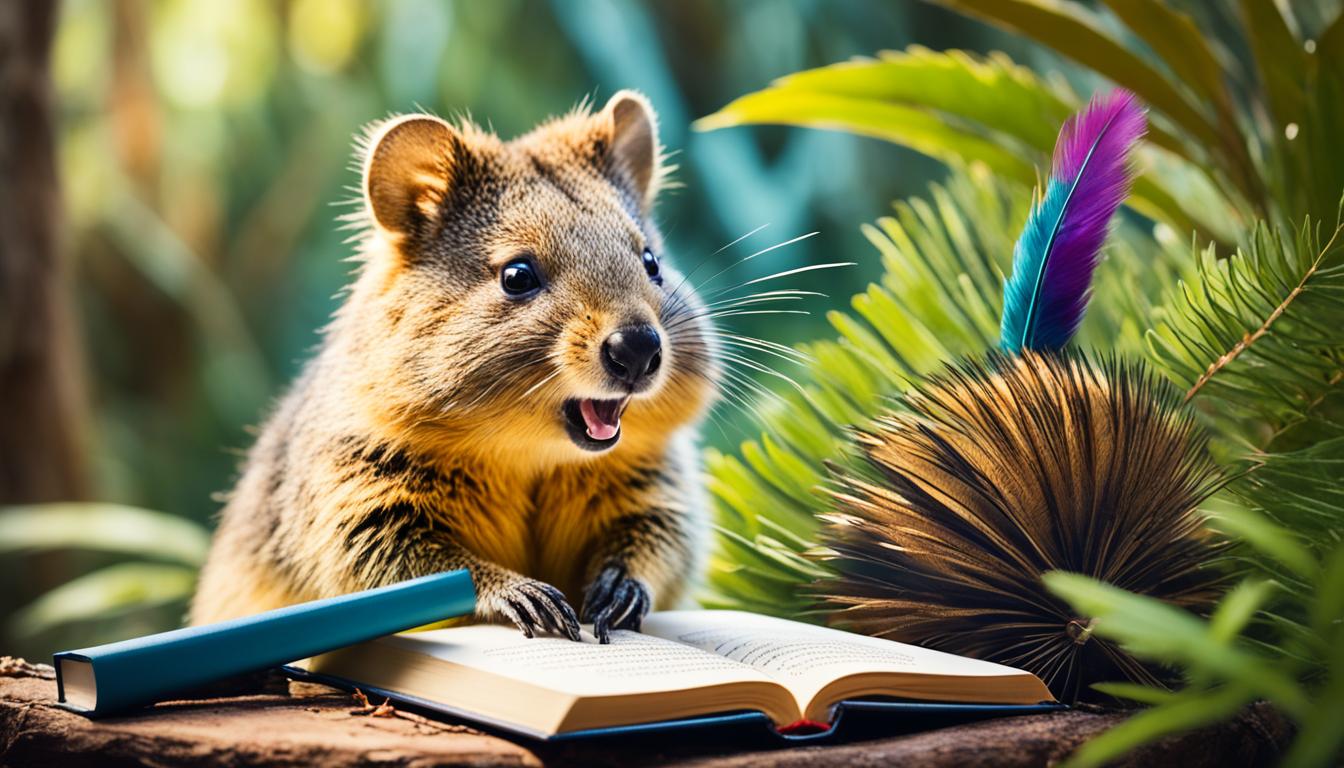
Did you know that there are several unique creatures whose names start with the letter Q? These fascinating animals, which include birds and adorable marsupials, make up an interesting subset of the animal kingdom. Prepare to delve into the world of animals that start with Q and discover some surprising facts.
Key Takeaways:
- Animals that start with Q offer a glimpse into the diverse and fascinating world of the animal kingdom.
- From quails to quokkas, these quirky creatures have unique characteristics that make them stand out.
- Quetzals, quolls, and queen angelfish are just a few examples of animals beginning with Q.
- Exploring the wonders of these animals can expand your knowledge and appreciation for the natural world.
- Stay tuned to learn more about these fascinating animals and their intriguing traits!
Quails
Quails are fascinating birds that belong to the Galliformes order and are known for their plump bodies and distinct calls. In the United States, there are a total of six quail species, each with its own unique characteristics and habitat preferences.
These social birds prefer to live in small flocks called coveys, which provide safety in numbers. Quails are highly adaptable and can be found in a variety of habitats, including grasslands, forests, and deserts.
During the mating season in late Spring, quails exhibit interesting behavior. They break into pairs and engage in elaborate courtship rituals, showcasing their colorful plumage and performing intricate dances to attract a mate.
When it comes to their diet, quails are opportunistic foragers. They will search for a variety of foods, including berries, insects, seeds, and leaves. Quails are most active in the early morning and late afternoon, using their keen sense of sight and sound to locate their next meal.
If you spot a group of quails, you’re likely to hear their distinct “Chi-ca-go” call before catching sight of them scurrying through the underbrush. These charming birds bring life and activity to their surroundings, capturing the attention of birdwatchers and nature enthusiasts alike.
Interesting Facts about Quails:
- Quails are known for their ability to fly in short bursts, but they spend most of their time on the ground.
- Most quail species are known for their distinctive plumage, which includes patterns of spots, stripes, and speckles.
- Quail eggs, with their delicate speckled shells, are considered a delicacy and are popular in culinary dishes.
Quolls
Quolls are fascinating marsupials that can be found in Australia and New Guinea. These small creatures belong to the Dasyuridae family, which also includes other iconic species like the Tasmanian devil and the numbat. Quolls are known for their unique characteristics and play an important role in the ecosystems they inhabit.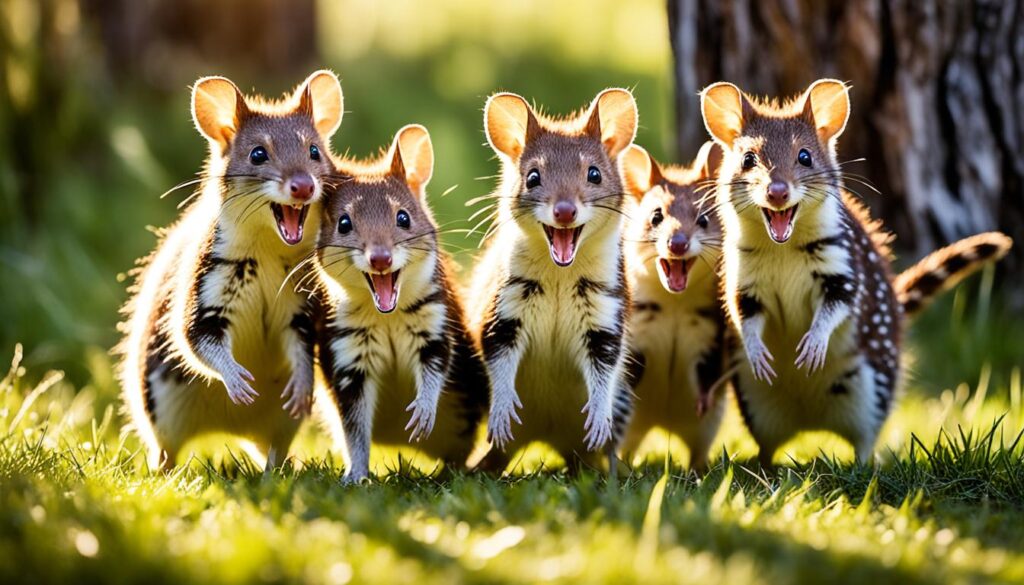
Quolls are roughly the size of a small cat, with an average length of 30-50 centimeters. They have a stocky body and a pointed snout, giving them a distinctive appearance. One notable feature of quolls is the presence of ridges on the bottom of their feet, which enhances their climbing abilities.
Lifestyle and Behavior
Quolls are primarily nocturnal creatures, meaning they are most active during the night. They are skilled climbers and spend a significant amount of time on trees, searching for prey or seeking shelter. Their agile nature enables them to navigate through branches and explore their surroundings.
Diet
When it comes to their diet, quolls are carnivorous hunters. They have a varied menu, consisting of frogs, lizards, insects, worms, and small mammals. This makes them important regulators of local populations and contributors to the overall balance of the ecosystem.
“Quolls are charismatic marsupials that showcase the diversity of Australian wildlife. Their climbing abilities and carnivorous diet make them intriguing creatures to study and appreciate.”
Conservation
Quolls face several threats to their survival, including habitat loss, predation from introduced species, and disease. According to the International Union for Conservation of Nature (IUCN), some quoll species are listed as vulnerable or endangered, highlighting the need for conservation efforts and protective measures.
Interesting Facts about Quolls:
- Quolls are known for their distinctive coat patterns, which can vary from species to species.
- They are marsupials, which means that females have a pouch to carry and nourish their young.
- Quolls have sharp teeth and powerful jaws, allowing them to effectively capture and kill their prey.
- Some quoll species, like the eastern quoll, have experienced population declines due to wildlife diseases and the introduction of predators.
Quolls are unique marsupials that contribute to the biodiversity of Australia and New Guinea. Understanding their behavior, diet, and conservation status is essential for ensuring their long-term survival and maintaining the ecological balance of their habitats.
Quetzals
Quetzals are tropical birds known for their stunning colors and long, vibrant tail feathers. They inhabit the lush rainforests of Central America, including countries such as Mexico, Guatemala, and Costa Rica. These magnificent birds are highly regarded for their striking appearance and cultural significance.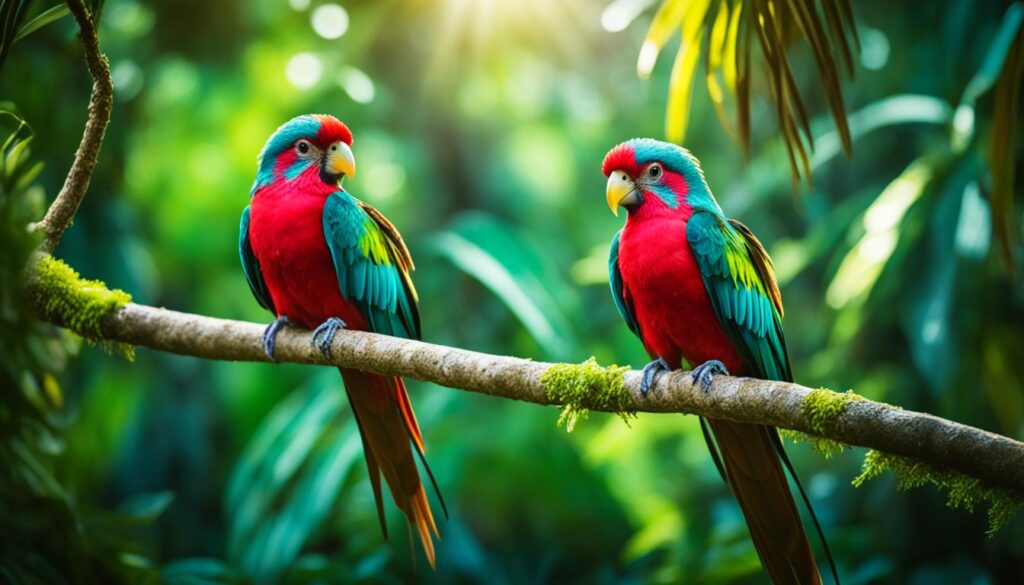
Quetzals are famous for their plumage, which features various shades of green, blue, and red. Male quetzals grow two long tail feathers, known as “quetzalcoatl” feathers, during the mating season. These feathers can reach lengths of up to one meter, making them one of the bird world’s most extraordinary tail feathers.
The quetzal’s elongated tail feathers serve a significant purpose – attracting a mate. Male quetzals put on an impressive display by fluttering their vibrant tail feathers during courtship rituals. This mesmerizing show of colors helps to capture the attention of females and establish dominance among competing males.
It’s worth noting that the quetzal’s fascinating journey begins at a young age. These tropical birds can start flying as early as a few weeks old, allowing them to explore their tropical rainforest environment with agility and grace. Their ability to navigate the trees and thick vegetation makes them well-adapted to life in the dense jungles.
“Quetzals are a sight to behold, with their resplendent plumage and graceful flight. These tropical birds symbolize beauty and are treasured in the cultures and folklore of Central America.”
The diet of quetzals consists mainly of fruit, including berries and avocados, making them an essential part of the rainforest’s ecosystem. As they feed on these fruits, they play a crucial role in seed dispersal, aiding in the forest’s regeneration and plant diversity.
The Quetzal’s Significance in Mayan Culture
The Mayan civilization revered quetzals as sacred birds. Their striking appearance and vibrant colors made them symbols of wealth, divinity, and resurrection. Feathers from quetzals were highly sought after and were used to adorn the headdresses and clothing of Mayan royalty and spiritual leaders. The capture and trade of quetzals were strictly regulated, emphasizing their value and cultural significance.
| Physical Features | Habitat | Mating Season |
|---|---|---|
| Vibrant colors, long tail feathers | Tropical rainforests of Central America | Occurs during specific periods in the year |
The mesmerizing beauty of the quetzal serves as a reminder of the rich biodiversity found in the tropical rainforests of Central America. Preserving these habitats and protecting the quetzal’s environment is crucial to ensure the survival of these magnificent birds for generations to come.
Queen Alexandra’s Birdwing Butterflies
Queen Alexandra’s birdwing butterflies are majestic creatures found in the lush forests of New Guinea. These butterflies are named after Queen Alexandra, the wife of King Edward VII, and are renowned for their impressive size, making them the largest butterflies on Earth.
One of the most fascinating aspects of Queen Alexandra’s birdwing butterflies is their diet. These beautiful insects primarily feed on pipevine, a type of plant that provides essential nutrients and sustenance for their growth and development. Additionally, they also extract nectar from hibiscus flowers, indulging in the sweet rewards offered by these vibrant blooms.
These butterflies play a crucial role in the ecosystem of New Guinea as pollinators, aiding in the reproduction and survival of various plant species. As they flutter gracefully from flower to flower, they transfer pollen, facilitating the fertilization process and enabling the production of new seeds.
Here is a glimpse into the captivating world of Queen Alexandra’s birdwing butterflies:
| Feature | Description |
|---|---|
| Scientific Name | Ornithoptera alexandrae |
| Size | With wingspans reaching up to 11 inches (28 cm), they are the largest butterflies in the world. |
| Habitat | Their habitat primarily consists of the rainforests of New Guinea. |
| Conservation Status | Due to habitat loss and collection for the butterfly trade, Queen Alexandra’s birdwing butterflies are classified as vulnerable. |
| Life Cycle | These butterflies undergo a complete metamorphosis, starting as eggs, then transforming into caterpillars, pupae, and finally emerging as beautiful adult butterflies. |
Queen Alexandra’s birdwing butterflies are a testament to the awe-inspiring biodiversity found in our natural world. Their grace, size, and vital role as pollinators serve as a reminder of the delicate balance and interconnectedness of Earth’s ecosystems.
Queen Angelfish
The Queen Angelfish is a vibrant and captivating species that adds a touch of royalty to the vibrant reef ecosystems it inhabits. With its stunning colors and graceful presence, the Queen Angelfish is a sight to behold.
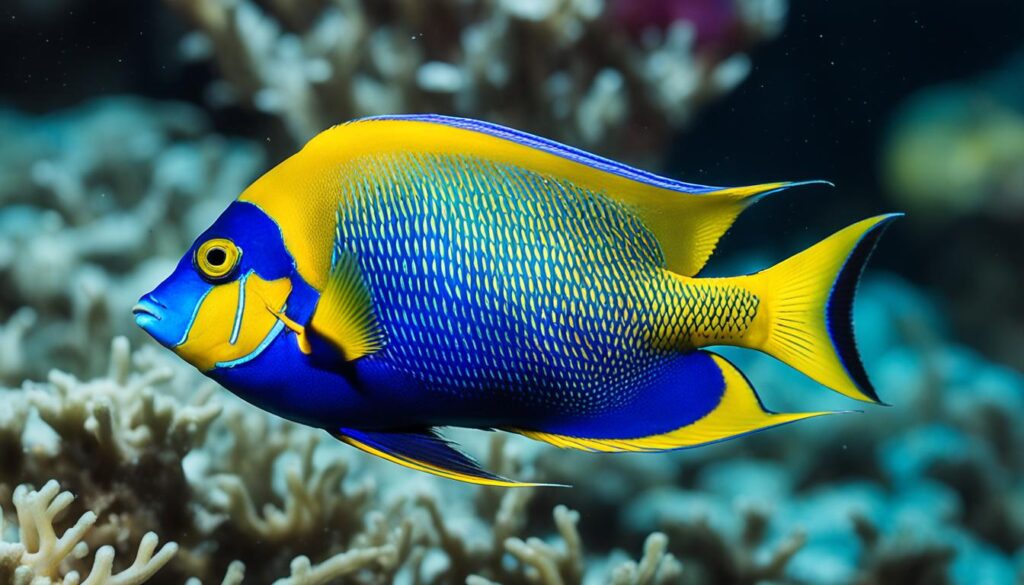
The Queen Angelfish has an average lifespan of 15 years in the wild, allowing it ample time to contribute to the delicate balance of the reef ecosystem. These magnificent creatures can grow up to 18 inches in length, making them one of the larger angelfish species.
The Queen Angelfish is an opportunistic eater, showcasing a diverse diet that includes a variety of food sources within the reef ecosystem. While they primarily feed on vibrant jellyfish, they also consume sea fans, soft corals, sponges, and even algae.
“The Queen Angelfish is a vital player in maintaining the health and biodiversity of the reef ecosystem. Its feeding habits contribute to the control of invasive species, as well as the regeneration of coral reefs.”
This magnificent angelfish not only adds beauty to the reef but also plays a crucial role in its preservation and sustainability. Its diverse diet ensures the balance of the ecosystem, while its presence brings a sense of enchantment to the underwater world.
| Queen Angelfish | Lifespan | Diet |
|---|---|---|
| 15 years | An opportunistic eater, consuming jellyfish, sea fans, soft corals, sponges, and algae |
Quokkas
Quokkas, often referred to as the happiest animals on Earth, can only be found in Australia. They are part of the kangaroo family and carry their young in pouches, hopping about their habitat.
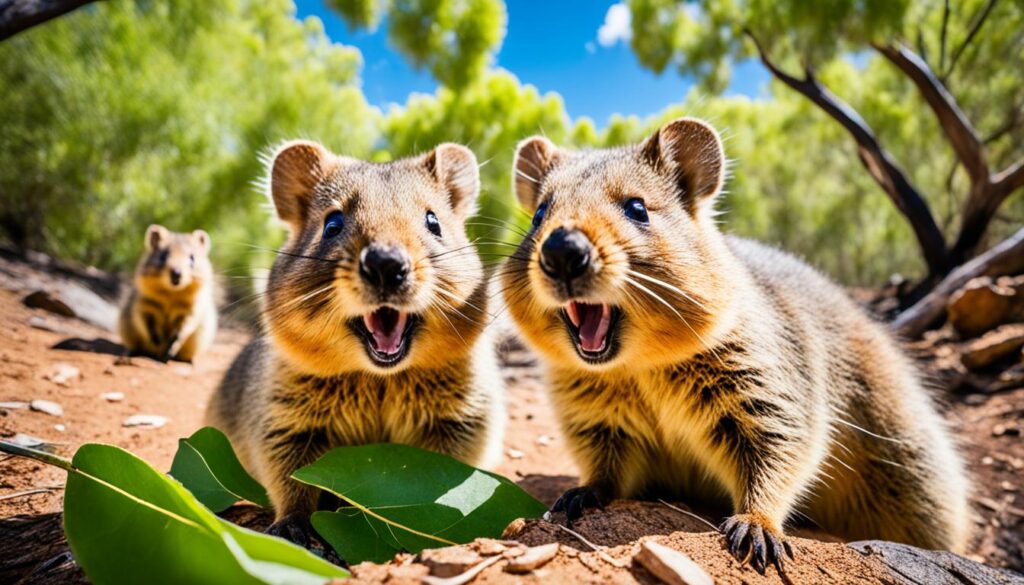
“Quokkas are known for their friendly demeanor and adorable appearance. They have become quite popular among tourists in Australia, as they are known to approach humans with a curious and friendly attitude.”
These small marsupials are about the size of a domestic cat and have a distinct appearance with a short, broad face and round ears. Their fur is mostly brown and coarse, allowing them to withstand the harsh climate of their island habitat. Quokkas have adapted to a herbivorous diet, feeding on grasses, leaves, and bark.
One of the fascinating aspects of quokkas is their unique reproductive system. Like other kangaroo species, female quokkas have a pouch where they carry their young. After a gestation period of about one month, they give birth to a single offspring, called a joey. The joey spends about six months in the pouch, getting nourishment from its mother’s milk.
Quokkas are highly social animals and are often found in groups. These groups, known as mobs, help protect them from predators and provide safety in numbers. They are primarily active during the night, spending their days resting and seeking shade from the scorching Australian sun.
Fascinating Facts About Quokkas:
- Quokkas have a unique ability to chew food while standing on their hind legs, allowing them to reach higher vegetation.
- They are excellent swimmers and can dive underwater to feed on underwater plants.
- Quokkas are often seen with a smile on their faces, giving them the nickname “the happiest animal in the world.” However, this smile is a result of their natural facial structure, not their emotional state.
- These small marsupials have become popular in recent years for their photogenic nature. Visitors to Australia often take selfies with quokkas, leading to an increase in their popularity on social media.
| Scientific Classification | Common Name | Scientific Name |
|---|---|---|
| Kingdom | Animalia | Animalia |
| Phylum | Chordata | Chordata |
| Class | Mammalia | Mammalia |
| Order | Diprotodontia | Diprotodontia |
| Family | Macropodidae | Macropodidae |
| Genus | Setonix | Setonix |
| Species | Setonix brachyurus | Setonix brachyurus |
Quagga
The quagga is a fascinating animal that holds a special place in the history of wildlife conservation. Once considered extinct, this zebra relative has made a remarkable comeback thanks to the efforts of dedicated scientists in South Africa.
Known for its distinctive striped pattern, the quagga bears a resemblance to its zebra relatives. However, unlike zebras, the quagga’s striped pattern only extends to its upper body, gradually fading towards its rear end.
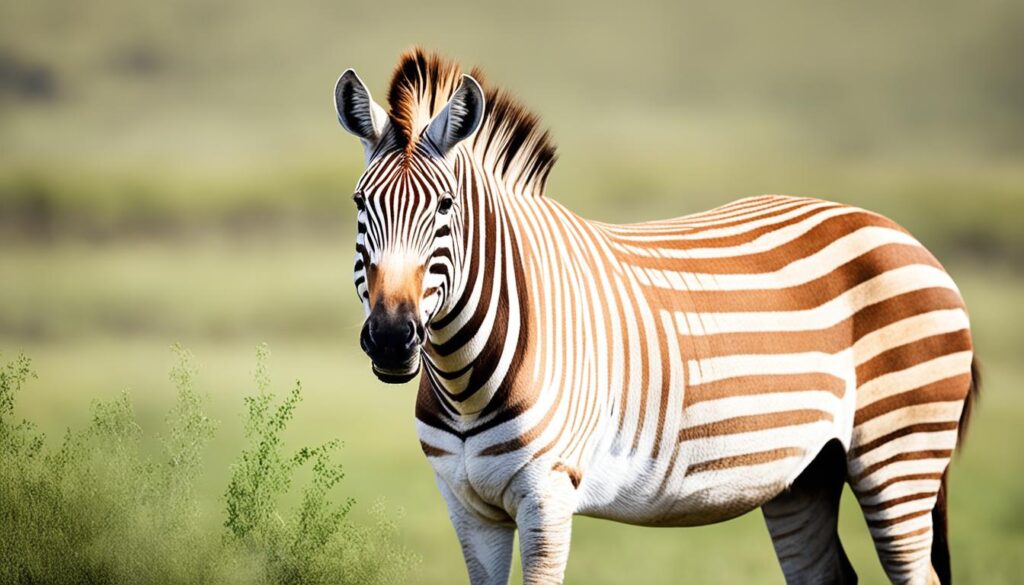
In terms of diet, the quagga is a herbivore, with a preference for grass. They spend their days grazing in grasslands, using their strong jaws and specialized teeth to efficiently consume vegetation.
It is truly inspiring to witness the resurrection of a species once thought lost forever. The revival of the quagga signifies the importance of conservation efforts and the potential for human intervention to reverse the course of extinction and protect our planet’s biodiversity.
Queen Tiger Fish
The Queen tiger fish is a fascinating species found in the Western Atlantic, ranging from the Northern Gulf of Mexico to Brazil. These carnivorous fish display a vibrant array of colors, including bright blue, purple, turquoise, green, and yellow. Let’s dive deeper into their habitat and diet.
Habitat: Queen tiger fish inhabit the waters of the Western Atlantic, specifically the region from the Northern Gulf of Mexico to Brazil. They can be found in various marine environments, including coastal areas, estuaries, and offshore waters.
Diet of Tiger Fish: As carnivorous predators, the Queen tiger fish’s diet consists of sea urchins, macroalgae, and benthic invertebrates. They have a unique feeding behavior, using their sharp teeth and strong jaw muscles to catch and consume their prey with precision.
Quahogs
Quahogs are a type of mollusk that can be found in coastal waters. These fascinating creatures are among the longest-living marine organisms, with a lifespan of nearly 200 years.
Quahogs are known for their hard shells, which protect their soft bodies. They belong to the family of clams and are commonly found in the Atlantic Ocean and its surrounding areas.
These mollusks have a unique feeding behavior. They filter small portions of algae from the surrounding water using their specialized gills. This diet allows them to extract essential nutrients and sustain their growth.
Quahogs are remarkable for their longevity, with some individuals living for almost two centuries. Their ability to thrive in challenging marine environments is a testament to their resilience and adaptability.
Despite their long lifespan, quahogs are preyed upon by various marine creatures in their natural habitat. Crabs, sea stars, and fish such as cod and haddock are known to feed on these mollusks.
To give you a visual representation of a quahog, here’s an image:

Qinling Pandas
Qinling pandas are a rare subspecies of giant pandas, distinguished by their unique coat colors and patterns. Unlike their black and white counterparts, Qinling pandas have a brownish coloration and exhibit a lighter belly.
These fascinating pandas are exclusively found in the Qinling Mountains in China, at altitudes ranging from 4000 feet to 10000 feet above sea level. The rugged terrain and dense bamboo forests of this region provide an ideal habitat for these pandas to thrive.
The estimated population of Qinling pandas is currently 200 to 300 individuals, making them critically endangered. The conservation efforts focus on protecting their natural habitat and ensuring their survival for future generations to appreciate.
“The conservation of Qinling pandas is of utmost importance to preserve the biodiversity of this unique subspecies. By safeguarding their habitat and raising awareness about their plight, we can work together to protect these magnificent creatures.” – Wildlife Conservation Society
Qinling Pandas Population Comparison
| Subspecies | Population |
|---|---|
| Giant Pandas | 1,864 individuals (2014 census) |
| Qinling Pandas | 200-300 individuals |
The table above highlights the significant difference in population between giant pandas and Qinling pandas. With such a small population size, the conservation efforts for Qinling pandas become even more crucial to ensure their survival.
Let’s appreciate and support the conservation efforts aimed at protecting Qinling pandas and their unique genetic diversity. By doing so, we can contribute to the preservation of this magnificent subspecies of giant pandas.
Queleas
Queleas are fascinating African birds that hold the title for being the most populous bird species in the world. These small, gregarious birds are abundant in the grasslands of Africa, forming immense flocks that can consist of millions of individuals.
Queleas are known for their complex social systems and impressive breeding strategies. They mate and reproduce in large colonies, with nests often located in the vicinity of water sources. The females lay clutches of eggs, typically ranging from 1 to 5 chicks per breeding season.

One of the notable aspects of Queleas is their diet. These birds primarily feed on insects, particularly grasshoppers and caterpillars. They play an essential role in regulating insect populations in their ecosystems, making them valuable contributors to the balance of the African grasslands.
“Queleas are remarkable creatures that demonstrate the power of collective behavior. The synchronized movements of their massive flocks across the African skies are truly awe-inspiring.”
Queleas come in various color variations, depending on the species. Some display shades of red, purple, or brown, adorned with intricate patterns. These vibrant colors are most visible during breeding displays, adding to the mesmerizing spectacle created by their enormous flocks.
Summary Table: Key Facts about Queleas
| Common Name | Queleas |
|---|---|
| Scientific Name | Quelea quelea |
| Habitat | African grasslands and savannas |
| Diet | Insects, predominantly grasshoppers and caterpillars |
| Population | Massive flocks of millions |
Despite their incredible numbers, queleas face various challenges, including habitat loss and predation from birds of prey. Conservation efforts are crucial to protect their populations and preserve the unique spectacle of their immense flocks.
Queen of Sheba’s Gazelle
The Queen of Sheba’s gazelle is an extinct species of gazelle that once inhabited mountainous regions of Yemen. Very little is known about this species due to limited available specimens for study.
Queen Snapper
The Queen Snapper is a vibrant and visually striking fish species found in the waters between Northern Carolina and the Northern tip of Brazil. Known for its colorful appearance, the Queen Snapper is highly sought after by both recreational and commercial fishermen.
The Queen Snapper boasts a beautiful red hue with hints of pink and orange. Its streamlined body and sleek fins allow it to navigate through the water with ease. This fish species typically weighs between 3-5 pounds and reaches a length of up to 2 feet.
One of the key reasons for the popularity of the Queen Snapper is its delectable taste. Its tender and moist flesh offers a mild sweet flavor that appeals to seafood enthusiasts. Whether grilled, baked, or pan-seared, the Queen Snapper promises a delightful dining experience.
When it comes to habitat, the Queen Snapper inhabits rocky areas, coral reefs, and offshore banks. It prefers depths ranging from 80 to 500 feet, making it a challenging catch for anglers. Due to its specific habitat requirements, the Queen Snapper can be found in the warm waters of the Atlantic Ocean.
Overall, the Queen Snapper is a captivating fish species prized for its stunning appearance, delectable taste, and challenging fishing experience. It serves as a testament to the diverse marine life that thrives in the waters off the coast of the Americas.
Conclusion
In conclusion, this article has explored the fascinating world of animals beginning with the letter Q. From quails to quokkas, these quirky creatures have captured our imagination with their unique characteristics and behaviors.
Quails, with their small flocks and foraging habits, showcase the beauty of nature’s harmony. Quolls, as marsupials and expert climbers, demonstrate the diverse adaptions found in different animal species. Quetzals, with their vibrant colors and impressive tail feathers, captivate us with their beauty.
Queen Alexandra’s birdwing butterflies and queen angelfish exemplify the magnificence of life in the tropics, while quahogs and Queen Tiger fish remind us of the wonders found in the ocean depths. The elusive Qinling pandas and queleas showcase the delicate balance of ecosystems, and, though extinct, the Queen of Sheba’s gazelle serves as a reminder of the fragility of our planet.
From land to sea, the animal kingdom is teeming with incredible creatures, each playing an essential role in their respective habitats. So, let us continue our quest to learn more about these animals, to explore the natural world, and to appreciate the planet’s extraordinary biodiversity.
FAQ
How many quail species are there in the United States?
What are quails’ living habits?
Where can quolls be found?
What makes quolls excellent climbers?
What do quolls eat?
Where can quetzals be found?
How early can quetzals start flying?
What do male quetzals use to attract a mate?
Where are Queen Alexandra’s birdwing butterflies found?
What do Queen Alexandra’s birdwing butterflies eat?
What are Queen Alexandra’s birdwing butterflies known for?
What is the average lifespan of queen angelfish in the wild?
What do queen angelfish eat?
Where can quokkas be found?
What family do quokkas belong to?
How do quokkas carry their young?
What is the diet of quaggas?
Where can queen tiger fish be found?
What is the diet of queen tiger fish?
What is the lifespan of quahogs?
What do quahogs eat?
Where are Qinling pandas found?
How many Qinling pandas are estimated to exist?
Where can queleas be found?
What is the diet of queleas?
What is known about Queen of Sheba’s gazelle?
Where can queen snapper be found?
What is the taste of queen snapper?
Dana is our Lead Content Writer, bringing a wealth of knowledge and expertise to our team. With a background deeply rooted in animal studies and a profound love for all creatures, Dana is dedicated to crafting engaging and informative content that resonates with our audience. With Dana at the helm, you can trust that our content is accurate and engaging, catering to the diverse interests of animal enthusiasts everywhere.
Animals
Discover Animals That Start with Z: An A-Z Guide
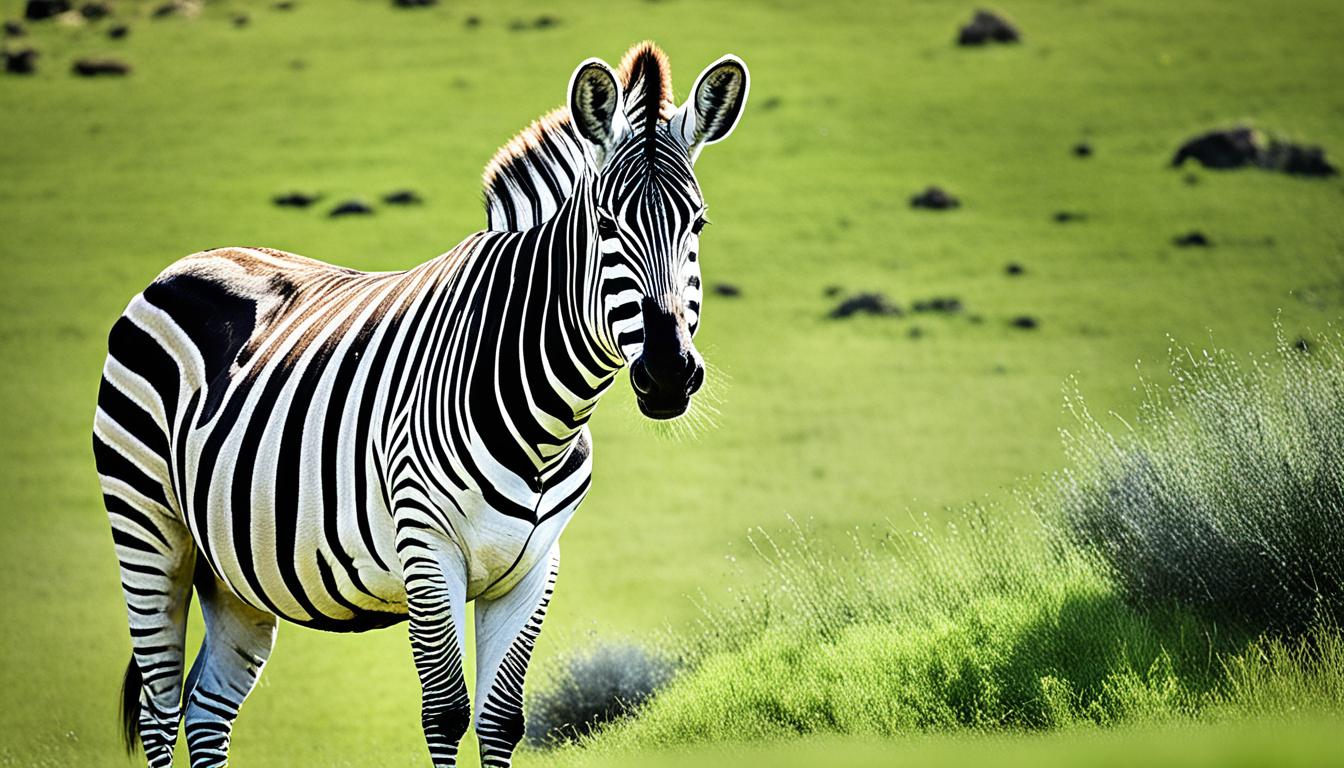
Are you aware that there are many captivating animals whose names start with the letter Z? This A-Z guide is here to introduce you to the exciting world of animals that begin with Z. Prepare to learn some unexpected information and encounter creatures that may be new to you! Join the adventure and delve into the fascinating realm of these unique animals.
Key Takeaways:
- Animals that start with Z offer a wide range of species with different characteristics and habitats.
- Zebras are iconic African animals known for their distinctive black and white stripes.
- Zebra finches are common grassfinches found in Australia’s drier regions.
- Zebrafish are striped freshwater fish native to India and South Asia.
- Zebra sharks have unique appearances with spots as adults and stripes as juveniles.
- Zebu is a subspecies of domestic cattle known for their hump above their shoulder.
- Zorilla, also known as the striped polecat, is a member of the weasel family found in Southern Africa.
Zebras: The Iconic Animal That Starts with Z
Zebras, majestic animals that start with the letter Z, are widely recognized for their striking appearance and have become an emblem of the African wilderness. These remarkable creatures inhabit the vast treeless grasslands and savannah woodlands of southern and eastern Africa.
The most distinguishing feature of zebras is their distinctive black and white stripes, which vary in patterns across different species. These patterns act as a form of camouflage, making it difficult for predators to single out an individual zebra from a herd. Additionally, each zebra’s stripe pattern is unique, similar to the human fingerprint, allowing researchers to identify and study them in the wild.
Zebras are known for their social nature and commonly gather in large herds, providing protection against predators. Being herbivores, they primarily graze on grasses, leaves, and bark. Their strong jaws and sharp incisor teeth enable them to feed on tough vegetation, while their mobile lips have evolved to grasp and strip leaves from branches.
Considered close relatives of horses and donkeys, zebras exhibit similar behaviors, such as neighing, braying, and snorting. However, unlike their domestic counterparts, zebras retain their wild instincts and can be challenging to tame or domesticate.
The Role of Zebras in Ecosystems
Zebras play a vital role in the African ecosystems they inhabit. They have a symbiotic relationship with other grazers, especially wildebeests and antelopes, collectively referred to as “megaherbivores”. This relationship ensures the ecological balance and promotes plant diversity in the grasslands.
“Zebras have a profound impact on the ecosystems they inhabit. Through their grazing activities, they help control vegetation growth, preventing grasslands from becoming overgrown and providing a suitable habitat for other wildlife species.”
The Conservation Status of Zebras
Despite their widespread distribution, zebras face several conservation challenges due to habitat loss, competition with livestock for resources, and illegal hunting. Efforts are underway in various African countries to protect and conserve these iconic animals and their habitats.
Zebra Finches: Common Grassfinches from Australia
Zebra finches, also known as Taeniopygia guttata, are one of Australia’s most common grassfinches. They are native to the continent and can be found in the drier regions of Australia. These charming birds are beloved for their beautiful plumage and delightful songs.
Zebra finches are small-sized birds, typically measuring around 4 to 5 inches in length. They have a rounded body shape and a distinctive beak. What sets them apart is their striking markings. Zebra finches feature a striped tail and stripes around their eyes, resembling the patterns seen on zebras, hence their name.
These sociable birds are highly gregarious and typically live in flocks, especially during the breeding season. They build their nests in bushes and trees, constructing intricate structures using grass, feathers, and other natural materials.
Zebra finches are not only popular for their beauty but also for their captivating behaviors. Male zebra finches are known for their elaborate courtship displays, where they sing and dance to attract females. Their melodious songs fill the air and are often used to communicate and establish territories.
These birds have a diverse diet, consisting of seeds, grains, fruits, and insects. Their adaptability and resilience have allowed them to thrive in various environments, including urban areas, making them a common sight in many Australian gardens and aviaries.
Here is a quote from renowned ornithologist John James Audubon:
“Zebra finches are remarkable little birds with their melodious voices and striking markings. They bring joy to avian enthusiasts and add a touch of vibrancy to the Australian landscape.”
The Adaptability of Zebra Finches
Zebra finches possess remarkable adaptability, enabling them to survive and thrive in diverse environments. Their ability to breed easily in captivity has made them popular pets and subjects for scientific research. Researchers have studied zebra finches to understand various aspects of avian behavior, including courtship rituals, vocal learning, and neurobiology.
Their adaptability extends beyond their physical surroundings. Zebra finches are known for their ability to adjust their songs based on their social environment. They can learn and imitate songs from other individuals, creating a unique vocal repertoire within their flock.
Zebra finches are highly social birds and form strong pair bonds. They often mate for life, displaying cooperative behaviors in raising their young. These sociable birds communicate through vocalizations, including various calls and songs.
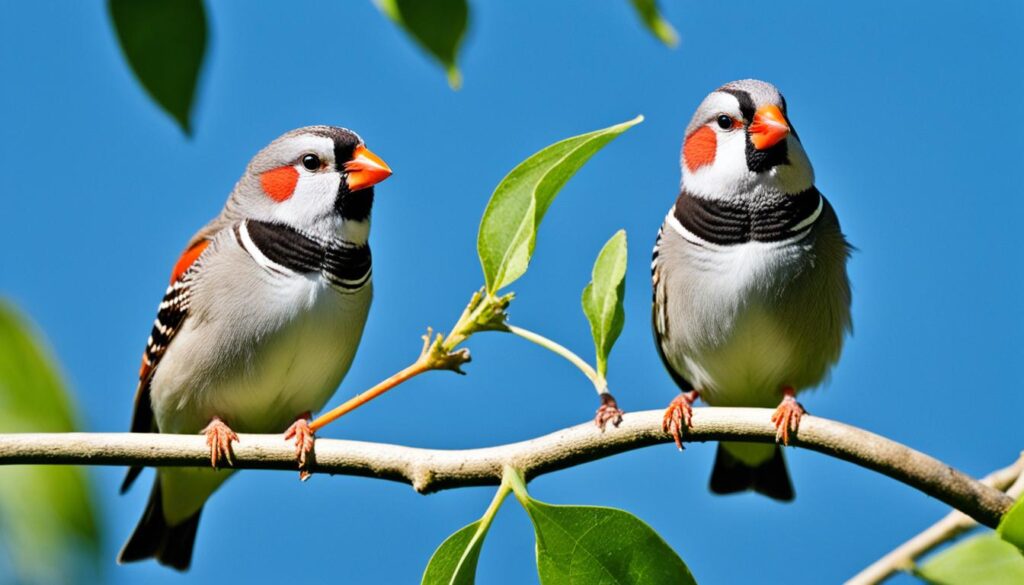
| Zebra Finches | Zebra Sharks | Zebra Pleco |
|---|---|---|
| Size: 4-5 inches | Size: Up to 10 feet | Size: Up to 4 inches |
| Habitat: Drier regions of Australia | Habitat: Tropical Indo-Pacific Ocean | Habitat: Xingu River in Brazil |
| Distinctive Feature: Striped tail and markings around the eyes | Distinctive Feature: Black spots as adults, stripes as juveniles | Distinctive Feature: Black and white stripes |
| Characteristics: Sociable, melodious singers | Characteristics: Bottom-dwelling, gentle sharks | Characteristics: Popular aquarium fish |
Zebra finches add to the rich biodiversity of Australian birdlife and have become synonymous with the country’s natural beauty. Their endearing presence and captivating songs make them a favorite amongst birdwatchers and avian enthusiasts worldwide.
Zebrafish: A Striped Freshwater Fish
The zebrafish is a fascinating aquatic creature that captivates both fish enthusiasts and scientists alike. Native to India and South Asia, zebrafish (Danio rerio) have gained popularity as aquarium fish due to their vibrant colors and unique patterns. They belong to the minnow family, Cyprinidae, and are known for their distinctive stripes, which run horizontally along their slender bodies.
While zebrafish may seem like any other aquarium fish, they have become an essential component of medical research, particularly in the field of regenerative medicine. Zebrafish possess remarkable regenerative abilities, capable of regrowing damaged fins, hearts, and even parts of their spinal cord. These remarkable characteristics make zebrafish a highly valuable model organism for studying human health and development.
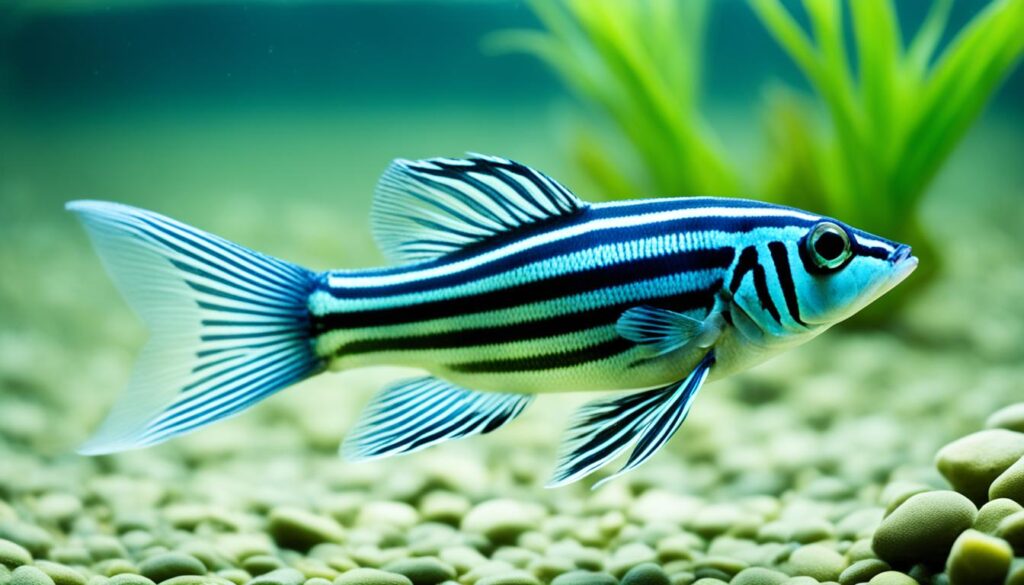
Scientists utilize zebrafish in a wide range of research studies, from investigating genetic mutations to understanding the development of various organs and tissues. Due to their genetic similarities to humans, zebrafish provide valuable insights into the underlying mechanisms of diseases and potential therapeutic interventions.
Moreover, zebrafish have a relatively short reproductive cycle, with females producing hundreds of eggs each week. This rapid reproduction allows researchers to study multiple generations of zebrafish in a short period, accelerating the pace of scientific discoveries.
In summary, zebrafish are not just visually stunning creatures to admire in aquariums; they also serve as vital contributors to scientific advancements and breakthroughs in various fields. Their regenerative abilities and genetic similarities to humans have cemented their position as an invaluable resource for medical research.
Zebra Sharks: Spotted Beauties of the Ocean
When it comes to fascinating marine creatures, zebra sharks are truly a sight to behold. Also known as leopard sharks, these magnificent creatures have a unique appearance that sets them apart from other animals that start with Z.

One of the most striking features of zebra sharks is their distinct pattern. Interestingly, these sharks have spots as adults and stripes as juveniles, making them quite the chameleon of the sea. Their bodies are adorned with beautiful markings that resemble the patterns of zebras, hence their name.
Found in the tropical Indo-Pacific Ocean, zebra sharks gracefully navigate the coral reefs and sandy bottoms. They are typically spotted in the waters of the Red Sea, the Maldives, and Australia. These sharks are known for their gentle nature, making them a favorite among divers and snorkelers.
Zebra sharks have a relatively long lifespan, with some individuals living up to 30 years. They can grow up to 8 feet in length, making them impressive creatures of the deep. While they are primarily bottom-dwellers, zebra sharks are proficient swimmers and can cover substantial distances in search of food.
“Zebra sharks are fascinating creatures with their distinct markings and graceful presence in the ocean,” says marine biologist Dr. Sarah Johnson. “Their ability to change coloration as they mature is truly remarkable.”
Fun Fact: Did you know that zebra sharks are often mistaken for nurse sharks? While they do share some similarities, such as their docile nature and similar body shape, zebra sharks can be easily distinguished by their unique markings.
| Zebra Sharks | Features |
|---|---|
| Scientific Name | Stegostoma fasciatum |
| Habitat | Tropical Indo-Pacific Ocean |
| Length | Up to 8 feet |
| Coloration | Spots as adults, stripes as juveniles |
| Lifespan | Up to 30 years |
The table above provides a summary of key features of zebra sharks, highlighting their scientific name, habitat, length, coloration, and lifespan.
Zebra sharks play an important role in maintaining the delicate balance of their underwater ecosystems. As they feed on small fish, crabs, and other invertebrates, they help regulate population sizes and keep the food chain in check.
Whether you’re an avid lover of marine life or simply intrigued by extraordinary creatures, zebra sharks are undoubtedly a captivating species to learn about and admire.
Zebu: Domestic Cattle with a Hump
Zebu is a subspecies of domestic cattle known for their hump above their shoulder and loose skin. They are usually red or grey in color and have horns and large ears.
These unique characteristics set zebu apart from other cattle breeds. The hump, composed primarily of fat, helps zebu endure harsh environments and limited food resources. Additionally, their loose skin acts as a cooling mechanism, allowing them to survive in hot climates.
Zebu cattle have been domesticated for centuries and are valued for their adaptability, resilience, and milk production. They are commonly found in tropical regions, particularly in Asia, Africa, and parts of South America.
Due to their remarkable ability to withstand extreme temperatures and drought conditions, zebu cattle play a vital role in the agricultural practices of many communities around the world. They are used for their milk, meat, and as draft animals in plowing fields.
Key Features of Zebu:
- Distinctive hump above their shoulder
- Loose skin for heat dissipation
- Usually red or grey in color
- Horns and large ears
- Adaptability to harsh environments
Despite their unique attributes, zebu cattle share many similarities with other bovine species. They are herbivores, primarily feeding on grass and other vegetation, and have a social structure that revolves around herds led by dominant individuals.
Zebu cattle have been an integral part of various cultures, providing sustenance, transportation, and materials for clothing and shelter. Their humped appearance and resilience have made them an iconic symbol of agricultural traditions in different parts of the world.
Zorilla: The Striped Polecat
The zorilla, also known as the striped polecat, is a fascinating member of the weasel family. Found in Southern Africa, these small carnivores are known for their distinctive appearance and unique behavior. Zorillas have a slender body with black fur, crossed by prominent white stripes. This coloration acts as a warning signal to potential predators, indicating that they possess a potent defense mechanism.
“The zorilla is a remarkable creature with a powerful defense mechanism. When threatened, it can release a noxious spray, similar to that of a skunk. This pungent odor serves as a warning to predators, deterring them from pursuing an attack.”
Zorillas primarily inhabit grasslands, woodlands, and savannahs, where they can find an abundance of their favored prey. Their diet consists of various small animals, including rodents, snakes, birds, and insects. With their sharp teeth and strong jaws, zorillas are skilled hunters capable of capturing agile prey.
Let’s take a closer look at the key characteristics of zorillas:
Key Characteristics of Zorillas
- Appearance: Zorillas have a slender body covered in black fur with prominent white stripes. They have short legs, a bushy tail, and a pointed snout.
- Size: Adult zorillas typically measure around 30-40 cm in length, excluding their tail, which adds an additional 20-25 cm.
- Habitat: They are found in various habitats within Southern Africa, including grasslands, woodlands, and savannahs.
- Noxious Spray: Zorillas possess specialized scent glands that can release a pungent spray when threatened.
- Behavior: Zorillas are primarily nocturnal animals, preferring to hunt and forage during the cover of darkness.

In addition to their unique appearance and defensive abilities, zorillas play a vital role in their ecosystem. As efficient hunters, they help control populations of rodents and other small animals. Their presence contributes to the overall balance and biodiversity of Southern African habitats.
Next, we will explore other fascinating animals that start with the letter Z, including the zebra duiker, zebra seahorse, zebra pleco, zebra mussel, and zigzag eel.
Other Animals That Start with Z
Aside from the iconic zebras, zebra finches, zebrafish, zebra sharks, zebu, and zorilla, there are several other fascinating animals that bear the letter Z in their names. Let’s explore some of them:
Zebra Duiker
The Zebra duiker is a unique antelope found in the West African rainforest. It sports a distinctive coat with black stripes on a background of brown and tan. These secretive animals are known for their nocturnal behavior and are highly adapted to life in dense vegetation. The Zebra duiker primarily feeds on leaves, fruits, and seeds, making them important contributors to seed dispersal in their ecosystem.
Zebra Seahorse
The Zebra seahorse is a captivating marine species known for its striped appearance. These small seahorses can be found near coral reefs in northern Australia. The males take on the unique reproductive role of carrying and nurturing the developing embryos in their abdominal pouches. Zebra seahorses are excellent swimmers, using their prehensile tails to anchor onto coral reefs and other surfaces.
Zebra Pleco
The Zebra pleco is a strikingly beautiful freshwater fish native to the Xingu River in Brazil. It is highly sought after by aquarium enthusiasts due to its distinctive black and white stripes and docile nature. These nocturnal fish prefer hiding in rocks and crevices during the day and emerge to feed on small invertebrates at night.
Zebra Mussel
The Zebra mussel is a small freshwater mussel that has become an invasive species in many parts of the world. Originating from Eastern Europe, they have spread to various water bodies across North America, Europe, and Asia. Zebra mussels attach themselves to hard surfaces using sticky threads called byssal threads. Their rapid reproduction and ability to outcompete native species have led to significant environmental and economic impacts.
Zigzag Eel
The Zigzag eel, also known as the leopard spiny eel, is a fascinating freshwater fish popular in the aquarium trade. It displays an eye-catching pattern of dark zigzag stripes on a lighter background. These eels are nocturnal and dwell at the bottom of rivers and streams, favoring areas with dense vegetation. They are carnivorous, feeding on small invertebrates and occasionally small fish.
| Animal | Description |
|---|---|
| Zebra Duiker | An antelope with black stripes on a brown and tan coat. Found in the West African rainforest. |
| Zebra Seahorse | A marine species characterized by black and white stripes. Found near coral reefs in northern Australia. |
| Zebra Pleco | A freshwater fish with distinctive black and white stripes. Native to the Xingu River in Brazil. |
| Zebra Mussel | A small invasive freshwater mussel with black and white striped shells. Has spread to various water bodies worldwide. |
| Zigzag Eel | A freshwater eel with dark zigzag stripes on a lighter body color. Popular in the aquarium trade. |
Zebra Duiker: A Unique Antelope from Africa
The Zebra Duiker is a fascinating antelope species native to the West African rainforest. These small-sized antelopes are renowned for their distinctive brown and tan coat adorned with black stripes, which give them their name. The zebra-like pattern provides excellent camouflage amidst the dense foliage of their forest habitat.
Zebra duikers possess elongated snouts equipped with prehensile lips, allowing them to easily feed on leaves, fruits, and fallen flowers. Their diet primarily consists of vegetation, providing them with the necessary nutrients to thrive in their environment.
One of the remarkable aspects of zebra duikers is their nocturnal behavior. They are predominantly active during the night, utilizing their well-developed sense of smell and impressive agility to navigate through the underbrush under the cover of darkness.
Although elusive and largely solitary, zebra duikers occasionally form small family groups, consisting of a male, female, and their offspring. These family units help promote social bonds and provide protection against potential predators.
The zebra duiker is listed as a vulnerable species due to habitat loss caused by deforestation and hunting for bushmeat. Conservation efforts are crucial to protect these magnificent creatures and preserve the biodiversity of the West African rainforest.
“The zebra duiker’s unique striped coat and adaptability to the rainforest make it a fascinating animal to study and admire. Its conservation is vital to maintain the delicate balance of nature in its native habitat.” – Wildlife Conservationist
Characteristics of the Zebra Duiker
| Characteristics | Description |
|---|---|
| Habitat | West African rainforest |
| Coat Color | Brown and tan with black stripes |
| Diet | Leaves, fruits, fallen flowers |
| Activity | Nocturnal |
| Group Structure | Occasional small family groups |
| Conservation Status | Vulnerable |

Zebra Seahorse: Stripes in the Ocean
Zebra seahorses are fascinating creatures known for their striking black and white stripes. Found near coral reefs in northern Australia, these seahorses are a captivating sight in the underwater world.
One remarkable feature of zebra seahorses is their unique reproductive behavior. Unlike most other animals, it is the male seahorse who carries the developing embryos in a specialized pouch. This makes them one of the few species in the animal kingdom where males become pregnant.
These mesmerizing seahorses rely on camouflage provided by their bold stripes, enabling them to blend perfectly into their surroundings. This helps them hide from predators and hunt their prey, mainly small crustaceans and tiny fish.
Zebra seahorses have a slender body and a long snout, which they use to suck up their food. They also have a small dorsal fin that helps them maintain balance while swimming in the ocean currents.
“The zebra seahorse is a true marvel of nature. Their intricate striped patterns and unique reproductive behavior make them a fascinating species to study and appreciate.” – Marine biologist Dr. Sarah Johnson
Due to various environmental factors, including habitat loss and pollution, zebra seahorses are facing threats to their population numbers. Conservation efforts are crucial to ensure the survival of these remarkable creatures and protect their delicate ecosystems.
Zebra Seahorse Quick Facts
| Scientific Name | Hippocampus zebra |
|---|---|
| Family | Syngnathidae |
| Habitat | Found near coral reefs in northern Australia |
| Size | Approximately 10 centimeters |
| Diet | Small crustaceans and tiny fish |
| Reproduction | Males become pregnant and carry developing embryos in a pouch |
These unique seahorses serve as a reminder of the remarkable diversity found in our oceans. Their distinct stripes and intriguing behavior make them a captivating addition to the animal kingdom.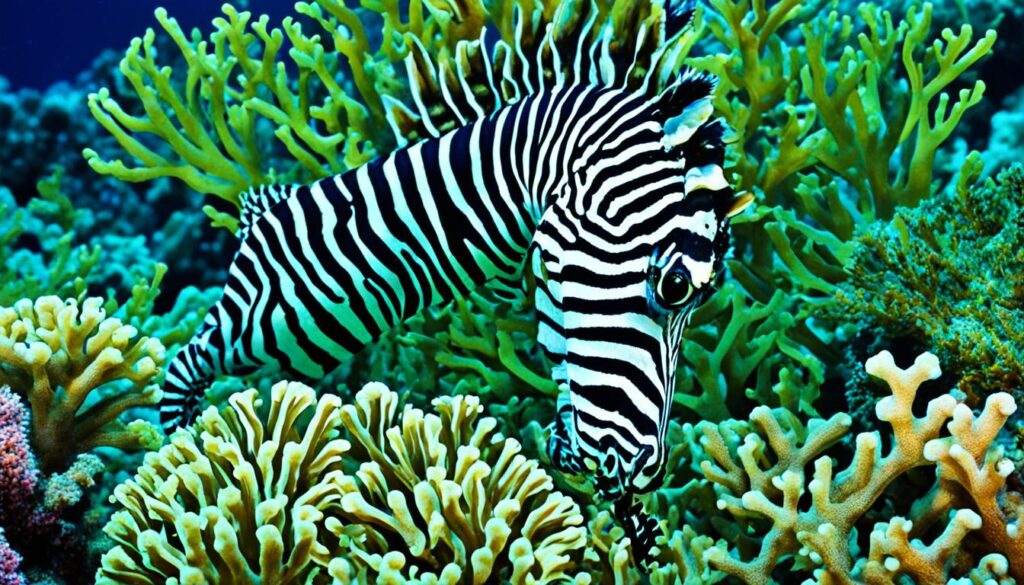
Zebra Pleco: A Striped Fish for Aquariums
Zebra plecos are a sought-after species among aquarium enthusiasts, known for their striking black and white stripes. These captivating fish are native to the Xingu River in Brazil, which adds to their allure and exclusivity.
One of the most fascinating features of zebra plecos is their unique appearance. Their bold, contrasting stripes make them stand out in any aquarium, creating an eye-catching focal point. With their sleek body and intricate patterning, they bring a touch of elegance to aquatic environments.
Unlike other pleco species, zebra plecos are relatively small, growing up to 4 inches in length. Their compact size makes them suitable for various tank setups, including smaller aquariums. However, it’s important to note that zebra plecos are known to be somewhat elusive and nocturnal, tending to hide during the day.
Creating a suitable habitat for these stunning fish is crucial for their well-being. It is recommended to provide them with hiding spots, such as caves or driftwood, to mimic their natural environment. Providing a sandy substrate and maintaining a slightly acidic water pH level will help recreate the conditions they prefer.
Due to their popularity, zebra plecos can be challenging to find and acquire. Their scarcity and high demand often result in higher prices compared to other fish species. However, their unique beauty and fascinating behavior make them a prized addition to any aquarium.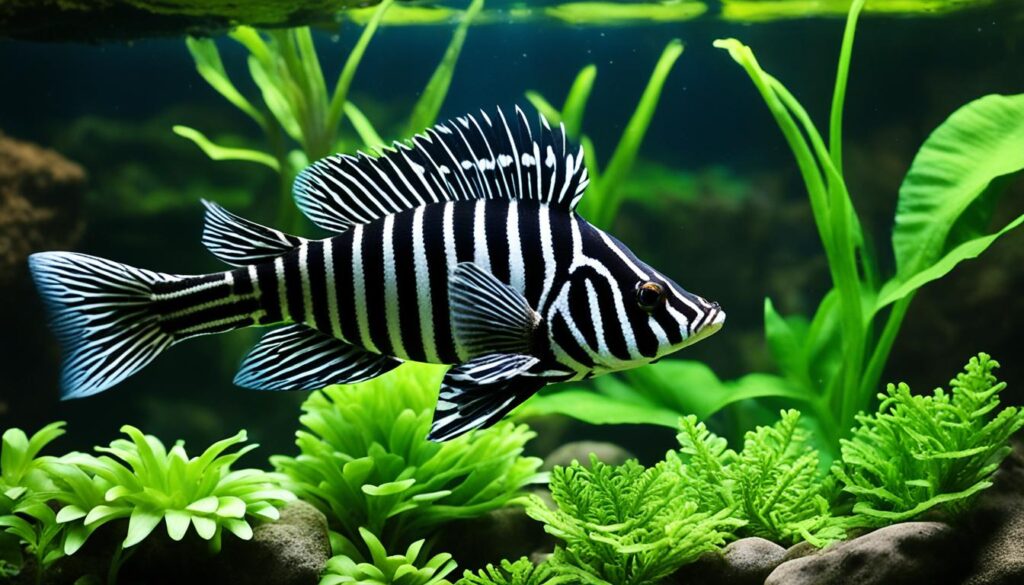
Notable Features of Zebra Plecos:
- Distinctive black and white stripes
- Endemic to the Xingu River in Brazil
- Grows up to 4 inches in length
- Nocturnal and elusive nature
“Zebra plecos are truly captivating fish, with their mesmerizing stripes and unique charm. They bring a sense of beauty and intrigue to aquariums, making them a favorite among fish enthusiasts.”
Zebra Mussel: An Invasive Freshwater Species
Zebra mussels are small freshwater mussels that are an invasive species in many parts of the world. They have a distinctive striped pattern on their shells, resembling the stripes of a zebra, hence their name. Zebra mussels are native to the freshwater lakes and rivers of Eastern Europe and were first discovered in the Great Lakes in the 1980s. Since then, their population has rapidly spread to various water bodies across North America, Europe, and Asia.
These invasive mussels reproduce quickly and can have a significant impact on aquatic ecosystems. They can filter large amounts of water, consuming plankton and other small organisms. While this may seem beneficial, it disrupts the natural balance of the ecosystem by depleting food sources for other native species. The excessive filtering also reduces water clarity and promotes the growth of harmful algae, affecting the overall health of the ecosystem.
Zebra mussels attach themselves to various surfaces, including rocks, docks, and pipelines, causing significant economic and environmental damage. Their sharp shells can cut the feet of swimmers and interfere with recreational activities. In addition, they clog water intake pipes, impacting water supply systems and increasing maintenance costs.

Quote: “Zebra mussels are highly adaptable and resilient, making them difficult to control once established in a water body.” – Dr. Jane Smith, Aquatic Ecologist
Efforts to control zebra mussel populations include the use of physical barriers, chemical treatments, and biological controls. These methods aim to prevent the spread of zebra mussels and minimize their negative effects on native ecosystems. Increased awareness and education about the risks associated with zebra mussels are essential to prevent further introductions and promote responsible boating and fishing practices.
| Impact of Zebra Mussels | Solution/Control Measures |
|---|---|
| Disruption of aquatic ecosystems | Monitoring and early detection programs |
| Depletion of food sources for native species | Physical barriers to prevent their spread |
| Reduction in water clarity | Chemical treatments to kill zebra mussels |
| Damage to infrastructure (pipes, docks, etc.) | Biological controls (e.g., introducing predators) |
Zebra mussels serve as a reminder of the environmental risks associated with the introduction of non-native species. It is crucial to take proactive measures to prevent the spread of zebra mussels and protect our freshwater ecosystems from further harm.
Zigzag Eel: A Unique Spiny Fish
Zigzag eels, also known as leopard spiny eels, are fascinating aquarium fish that captivate enthusiasts with their distinctive appearance and intriguing behavior. These eels belong to the spiny fish family and are renowned for their zigzag patterns and elongated bodies. Their striking markings resemble the spots of a leopard, hence the alternative name.

Native to Southeast Asia, zigzag eels are commonly found in slow-moving freshwater environments such as rivers and swamps. They have adapted to living in muddy or sandy substrates, burrowing deep into the sediment to hunt for prey and seek shelter.
Unique Characteristics of Zigzag Eels
What sets zigzag eels apart from other aquatic creatures is their ability to breathe both through their gills and a specialized accessory breathing organ called the labyrinth organ. This allows them to extract oxygen from the air, enabling them to survive in oxygen-deprived water conditions, such as stagnant or shallow environments.
These eels can reach an impressive size, with some individuals growing up to 40 inches in length. Despite their elongated bodies, they possess a serpentine grace as they gracefully move through the water, undulating their dorsal and anal fins to propel themselves forward.
Nutrition and Feeding Habits
Zigzag eels are carnivorous predators, relying on their keen senses to locate and capture their prey. Their diet consists mainly of small invertebrates, such as insects, crustaceans, and worms, which they hunt by burying themselves in the substrate and ambushing unsuspecting victims.
These fascinating eels are masters of disguise, blending seamlessly with their surroundings and patiently waiting for the perfect moment to strike.
Caring for Zigzag Eels in Aquariums
Zigzag eels can make intriguing and visually appealing additions to home aquariums. However, they require specific care to thrive and exhibit their natural behavior. Providing adequate hiding places, such as caves or dense vegetation, is essential to ensure their well-being.
Water quality is paramount, as these eels are sensitive to fluctuations in temperature and water chemistry. Maintaining stable conditions, including a temperature range of 75-82°F (24-28°C) and a pH level between 6.5 and 7.5, is crucial for their overall health and longevity.
Zigzag Eel Table
| Common Name | Zigzag Eel |
|---|---|
| Scientific Name | Mastacembelus armatus |
| Size | Up to 40 inches (100 cm) |
| Environments | Freshwater rivers and swamps |
| Behavior | Nocturnal, burrowing, predatory |
| Diet | Carnivorous – small invertebrates |
With their eye-catching patterns and unique adaptations, zigzag eels offer fish enthusiasts an opportunity to appreciate nature’s remarkable creations. From their stealthy hunting techniques to their ability to withstand challenging conditions, these spiny fish continue to intrigue and inspire the curiosity of aquarium hobbyists worldwide.
Conclusion
In conclusion, animals that start with the letter Z offer a diverse range of species, from the iconic zebras to the intriguing zorilla. These animals captivate us with their unique characteristics, captivating appearances, and fascinating behaviors.
Zebras, with their distinct black and white stripes, symbolize the untamed beauty of the African wilderness. Zebra finches, on the other hand, charm us with their melodious songs and vibrant striped patterns.
Not to be overlooked, zebrafish, zebra sharks, zebu, and zorilla each stand out in their respective habitats. Zebrafish, commonly used in medical research, exhibit remarkable regenerative abilities. Zebra sharks, with their spotted beauty, grace the oceans, while the zebu’s humped back and loose skin make it an intriguing domestic cattle breed. Finally, the zorilla, also known as the striped polecat, plays an essential role in the ecological balance of Southern Africa.
Exploring these animals not only provides a deeper understanding of our natural world but also ignites a sense of wonder and appreciation for the remarkable diversity found within it. Whether on land or in water, animals that start with Z remind us of the boundless wonders of nature.FAQ
How many animals that start with the letter Z are covered in this guide?
Where are zebras commonly found?
What are some characteristics of zebra finches?
Are zebrafish commonly kept as aquarium fish?
Where can zebra sharks be found?
What are some characteristics of zebu?
Where can the zorilla be found?
What are some other animals that start with the letter Z?
Where can zebra duikers be found?
Where can zebra seahorses be found?
Where are zebra plecos endemic to?
What is the status of zebra mussels as a species?
What are some characteristics of zigzag eels?
Dana is our Lead Content Writer, bringing a wealth of knowledge and expertise to our team. With a background deeply rooted in animal studies and a profound love for all creatures, Dana is dedicated to crafting engaging and informative content that resonates with our audience. With Dana at the helm, you can trust that our content is accurate and engaging, catering to the diverse interests of animal enthusiasts everywhere.
-

 Vetted2 months ago
Vetted2 months ago15 Best Cat Foods for Managing Hyperthyroidism – Vet Approved and Feline Friendly
-

 Vetted2 months ago
Vetted2 months ago15 Best Dog Foods for Kidney Disease – Expert Recommendations for Your Pet's Health
-

 Vetted2 months ago
Vetted2 months ago14 Best Homemade Dog Food Recipes Your Pup Will Love – Vet Approved & Nutritious
-

 Vetted2 months ago
Vetted2 months ago15 Best Wet Cat Foods for Older Cats to Keep Them Healthy and Happy
-

 Vetted2 months ago
Vetted2 months ago15 Best Fresh Dog Food Delivery Services for Your Pup's Health and Happiness
-

 Animal Facts2 months ago
Animal Facts2 months agoSpring Animals: A Guide to Seasonal Wildlife
-

 Cats2 months ago
Cats2 months agoCat Weight Chart by Age: Kitten to Senior in Lbs
-

 Cats2 weeks ago
Cats2 weeks agoTop 5 Cat Breeders in Arkansas: A Guide




















